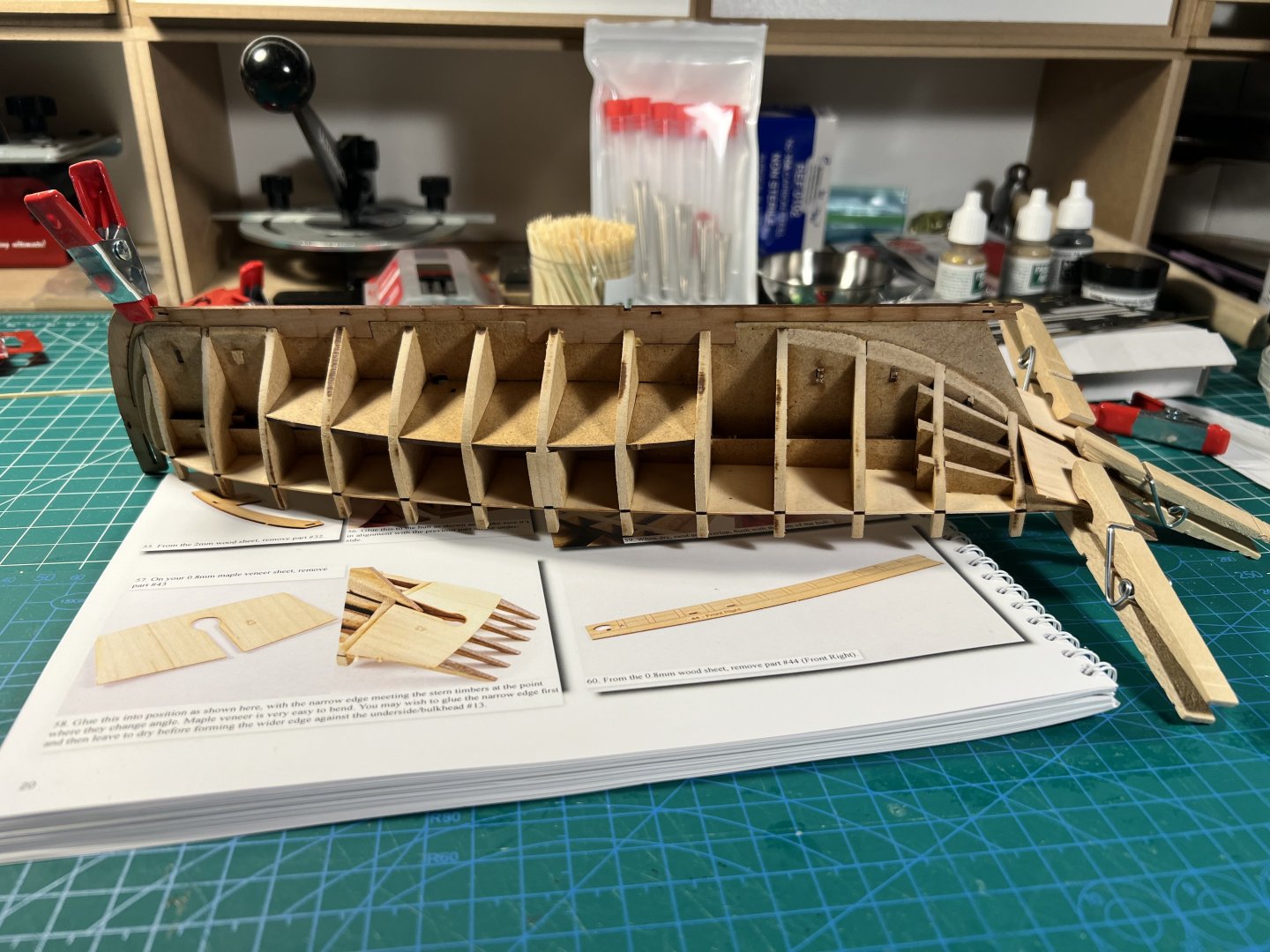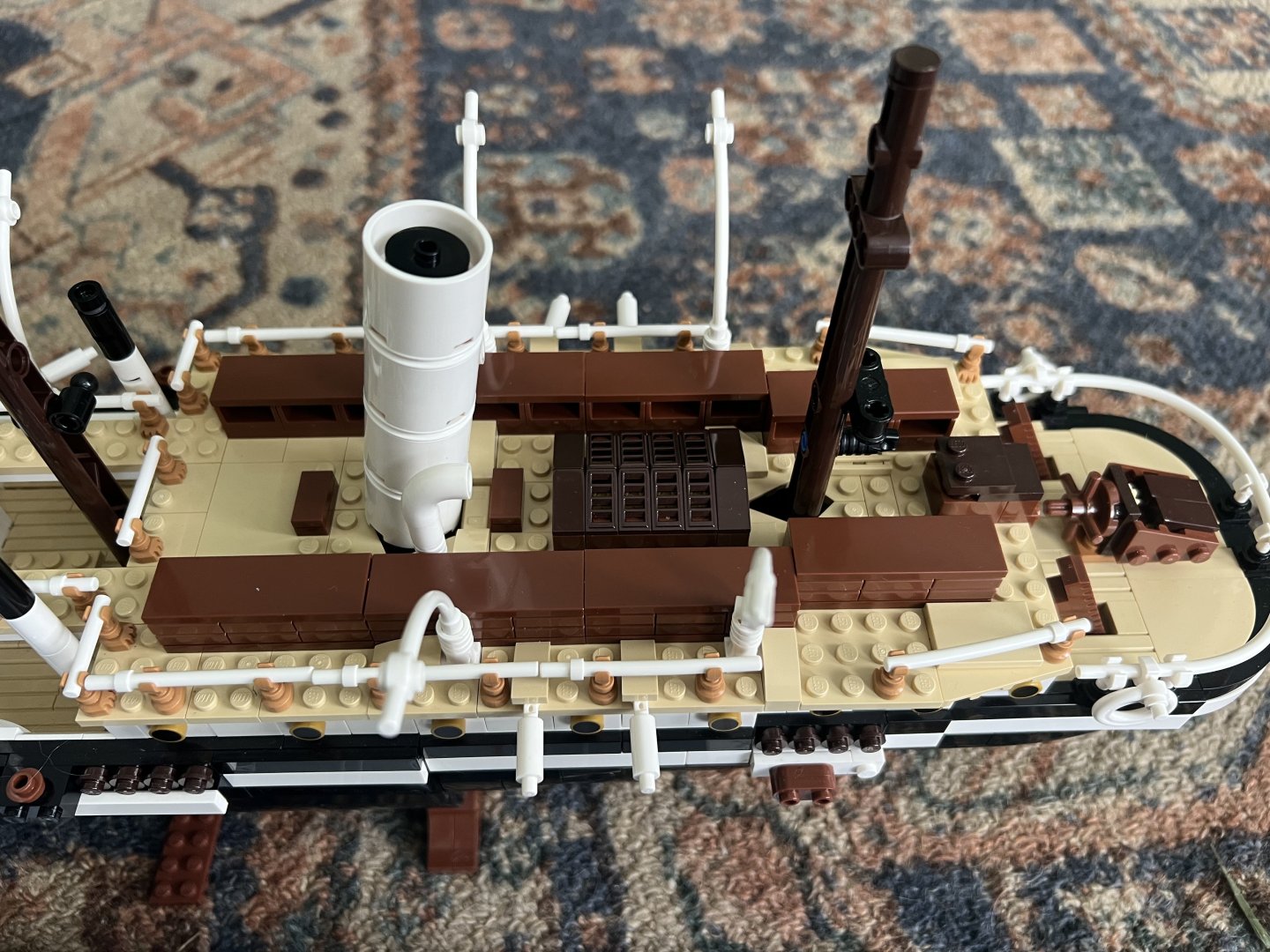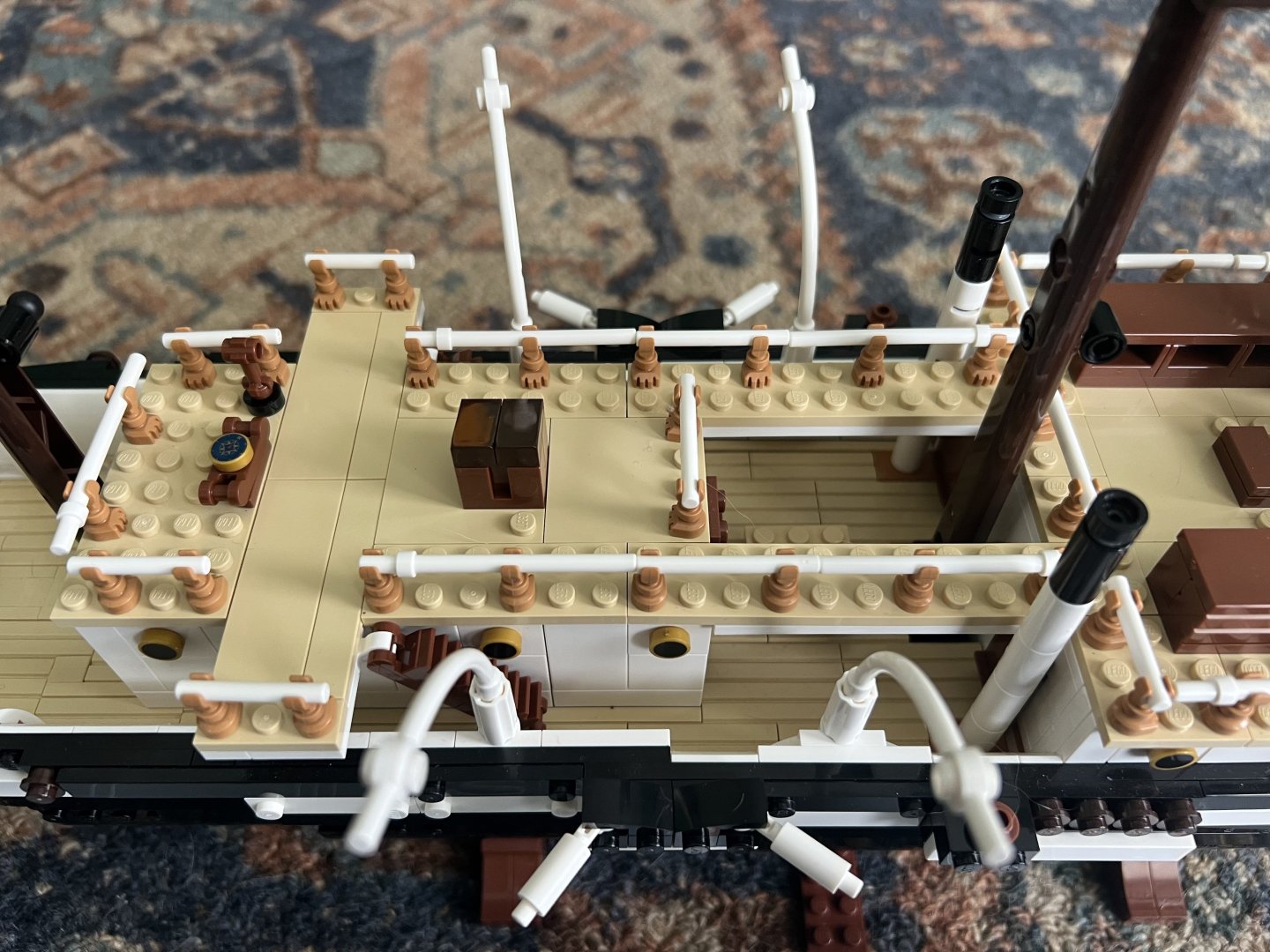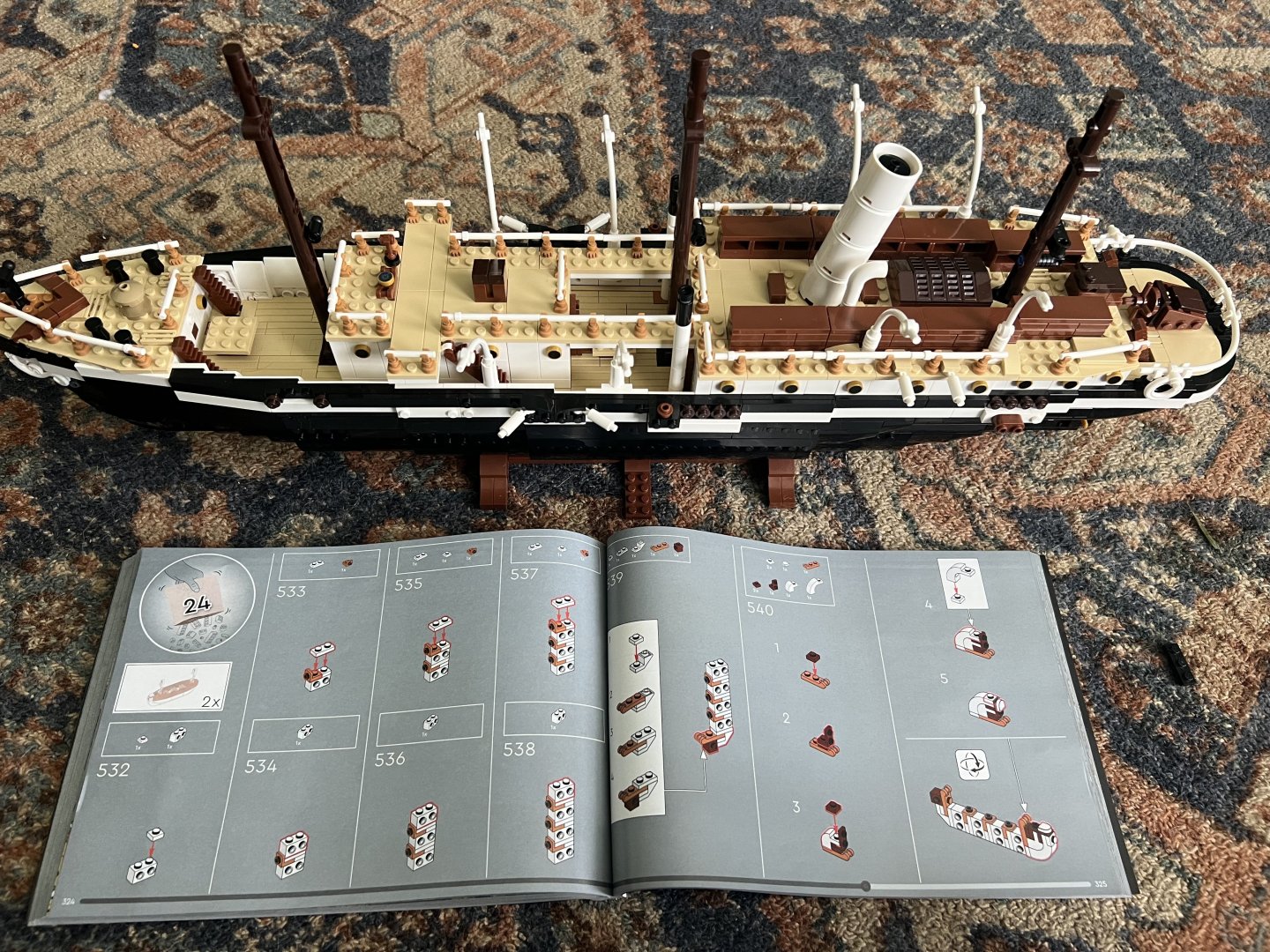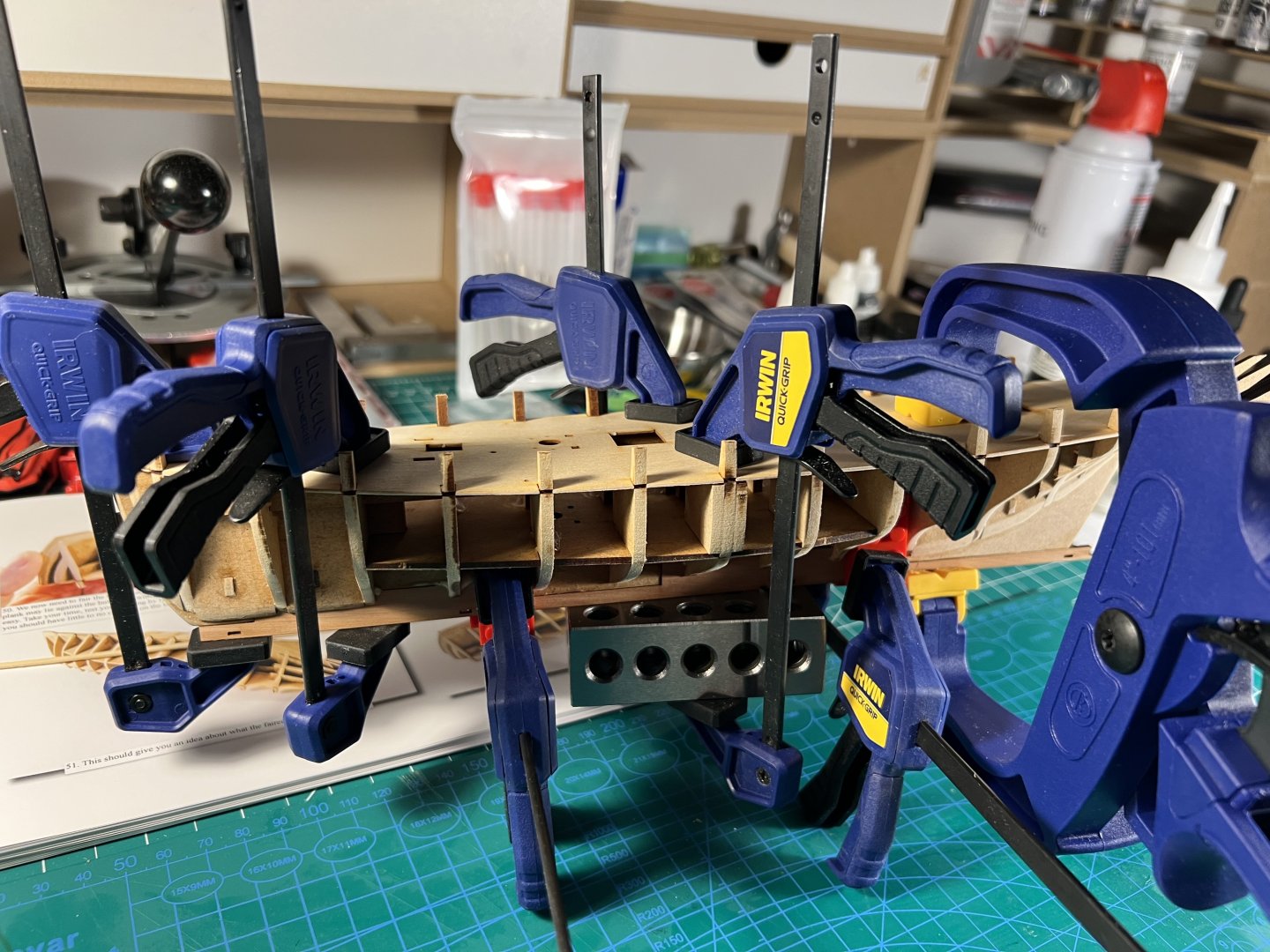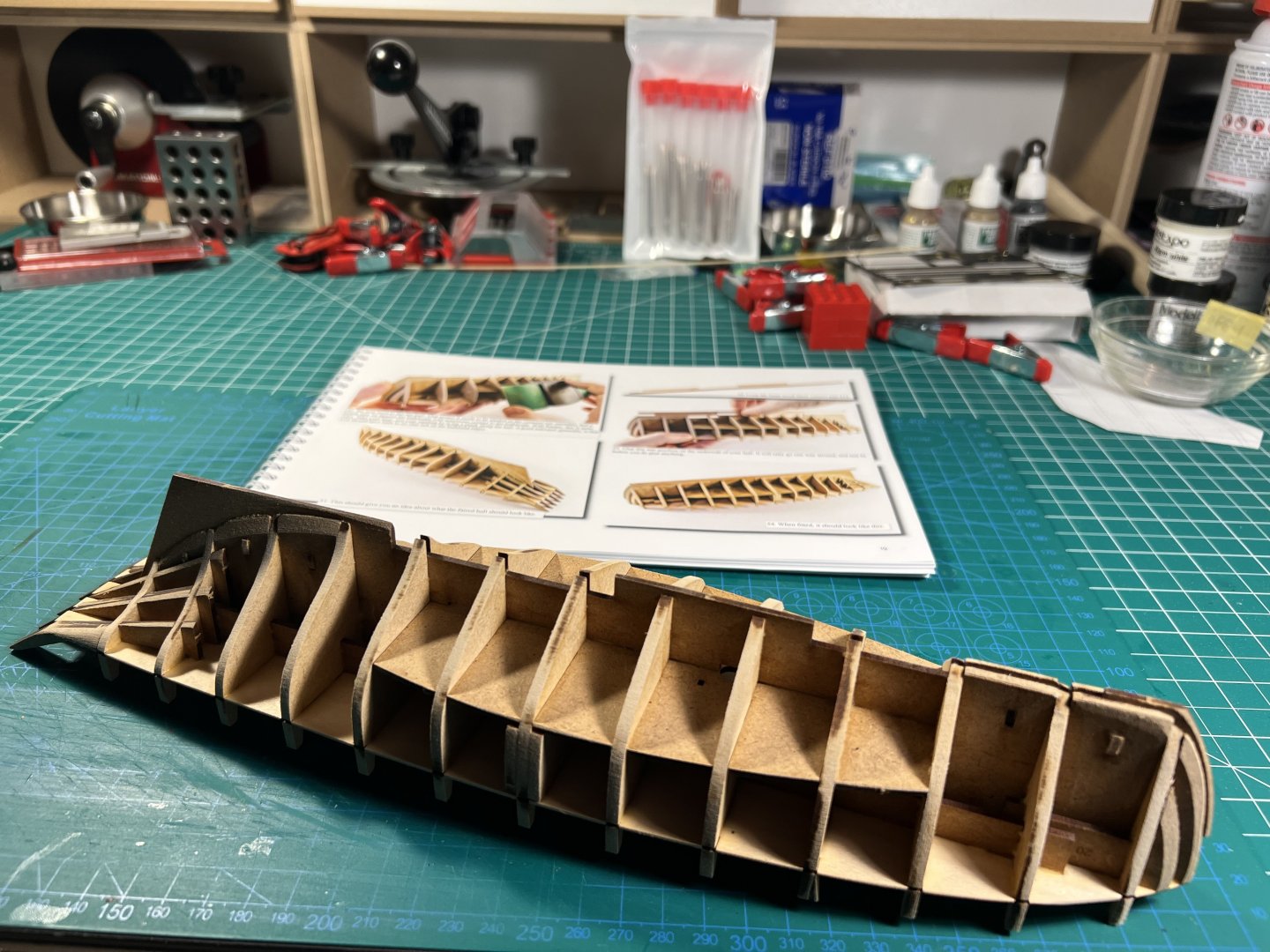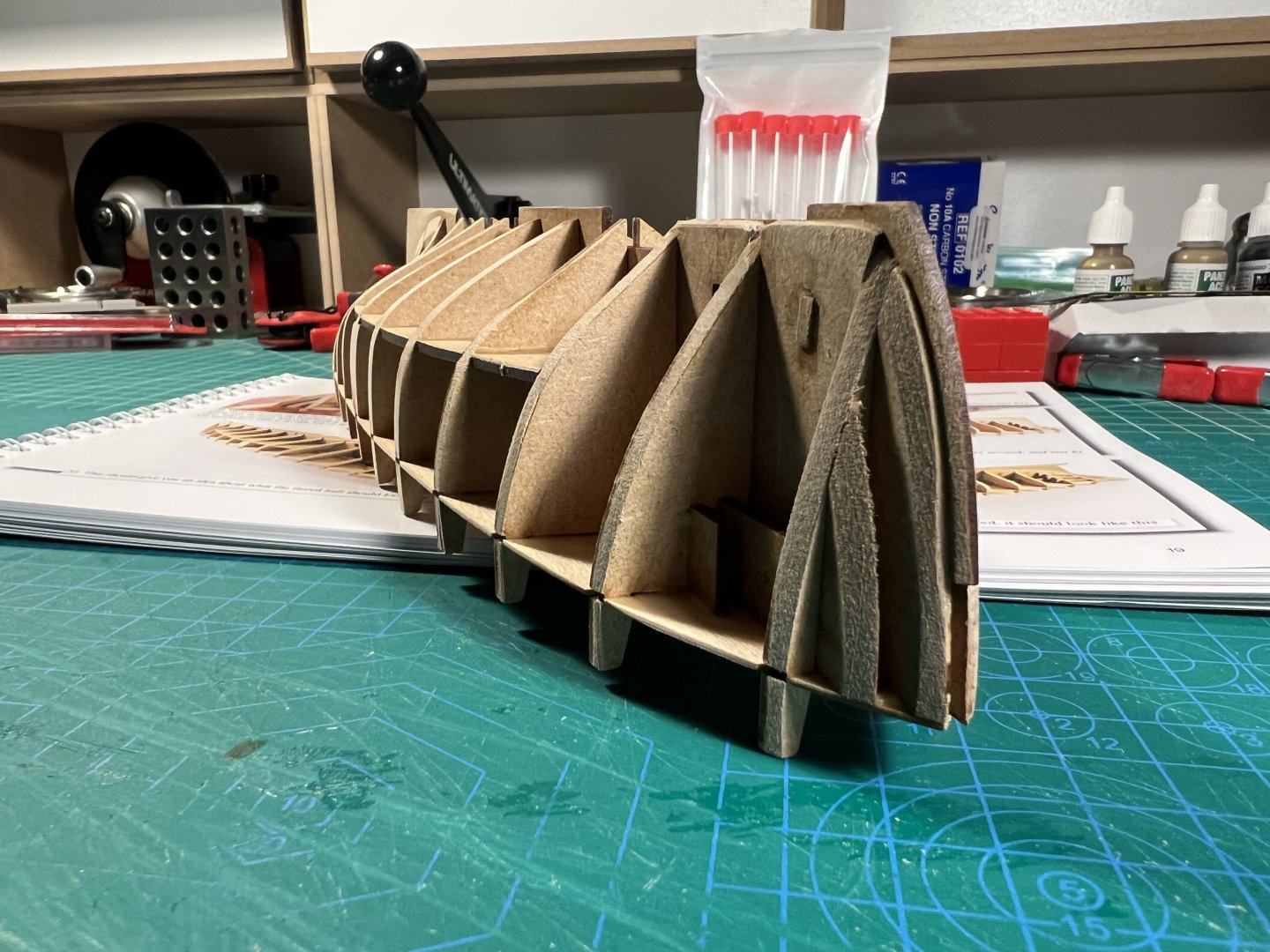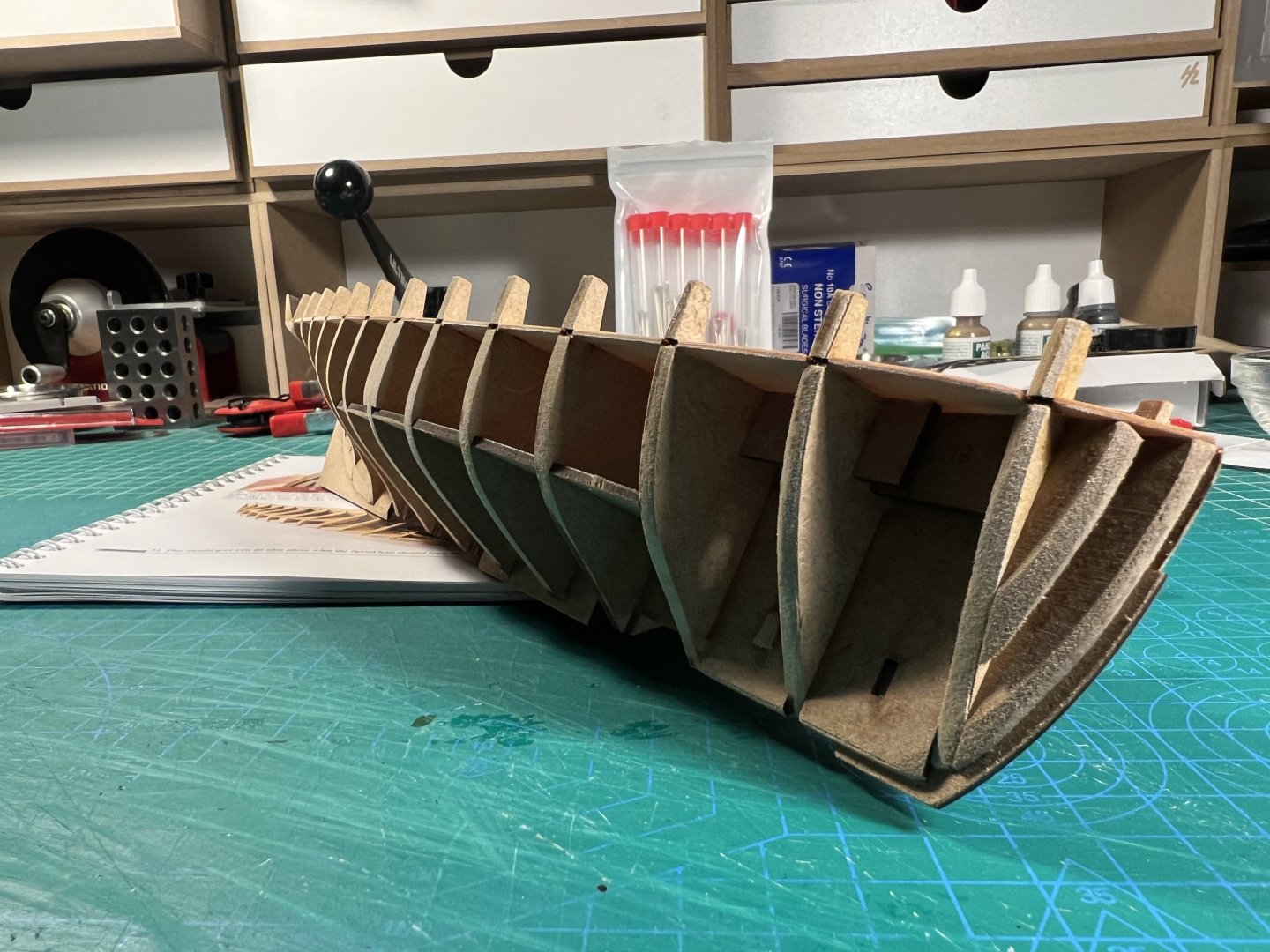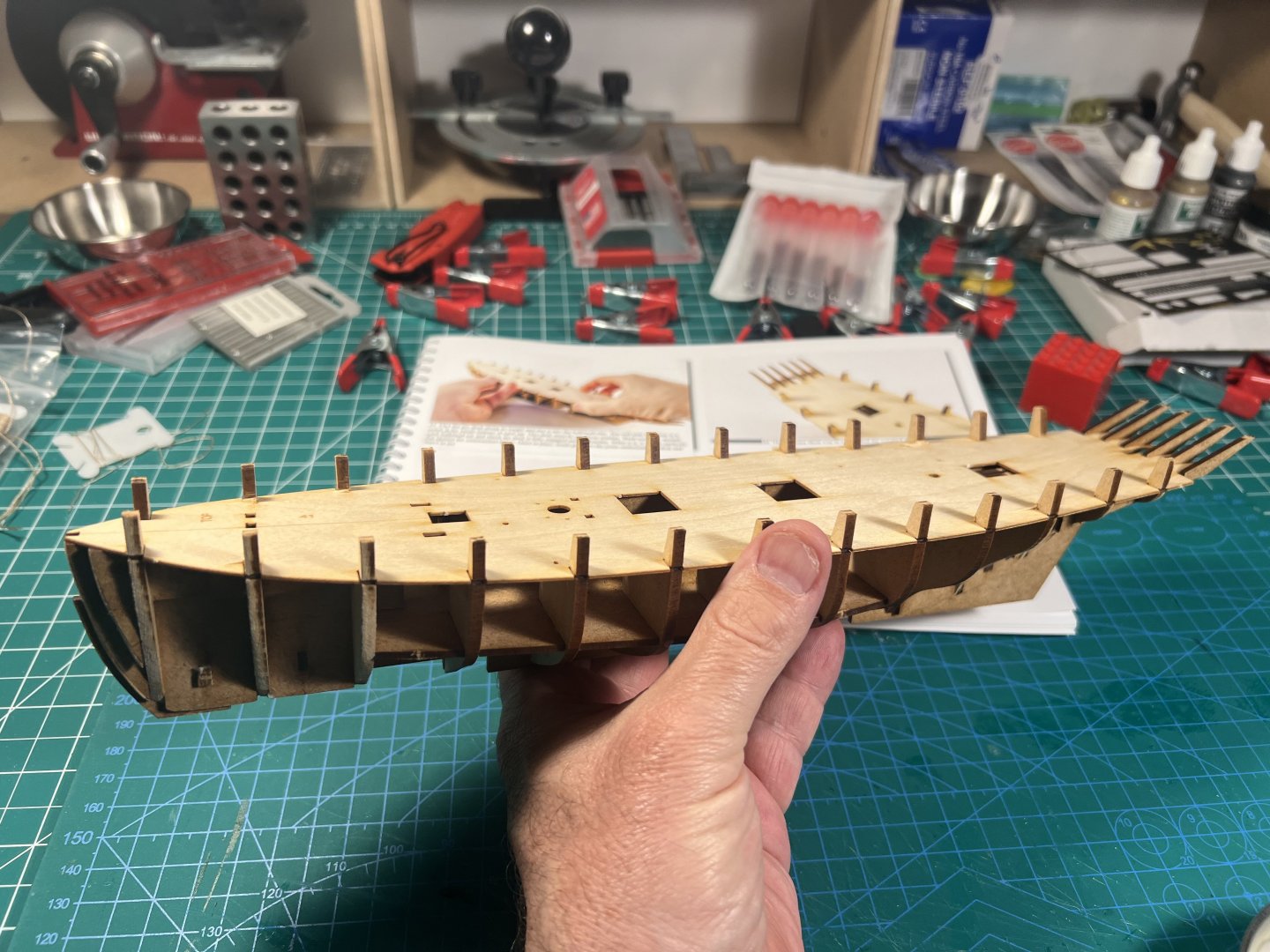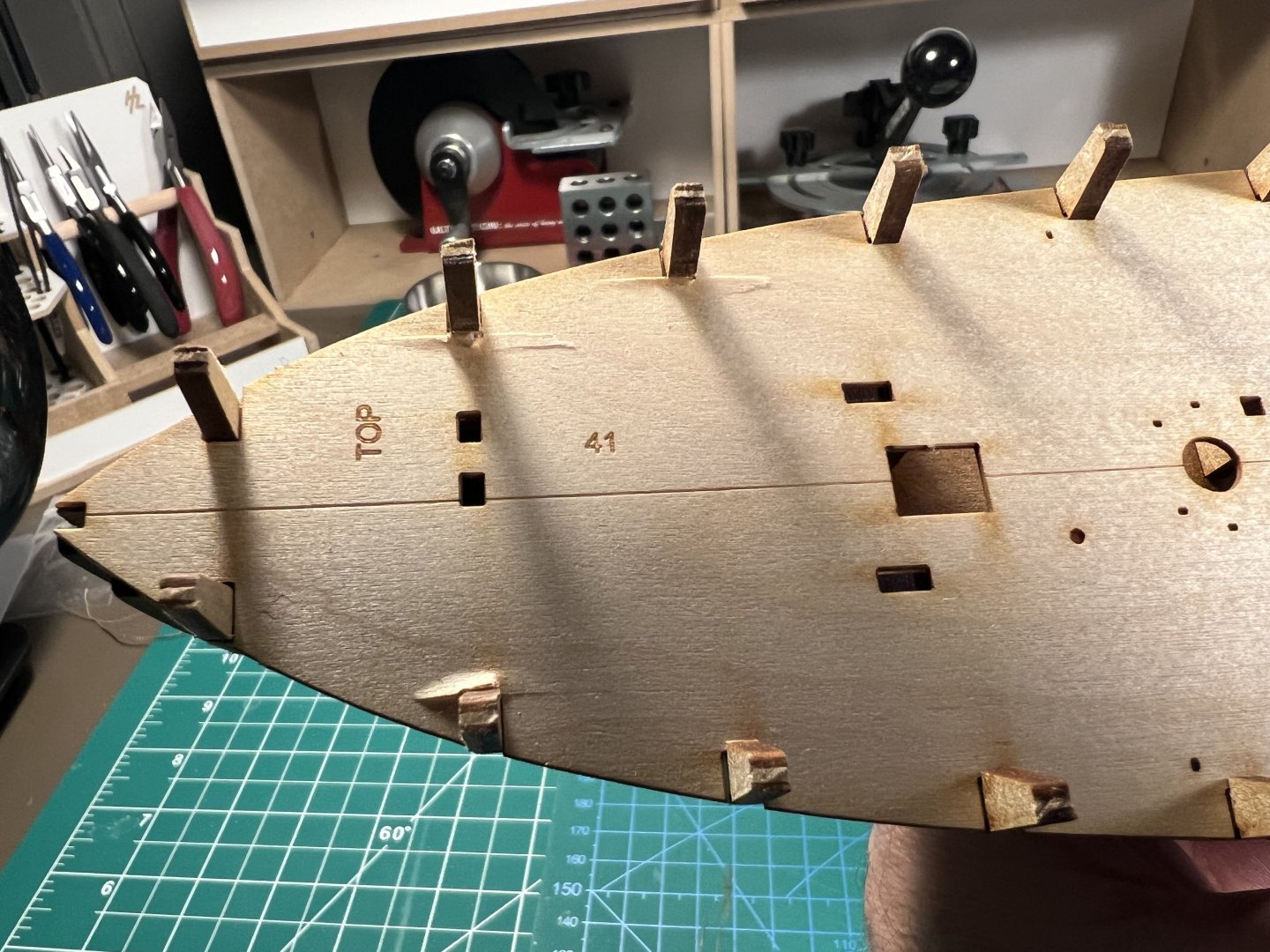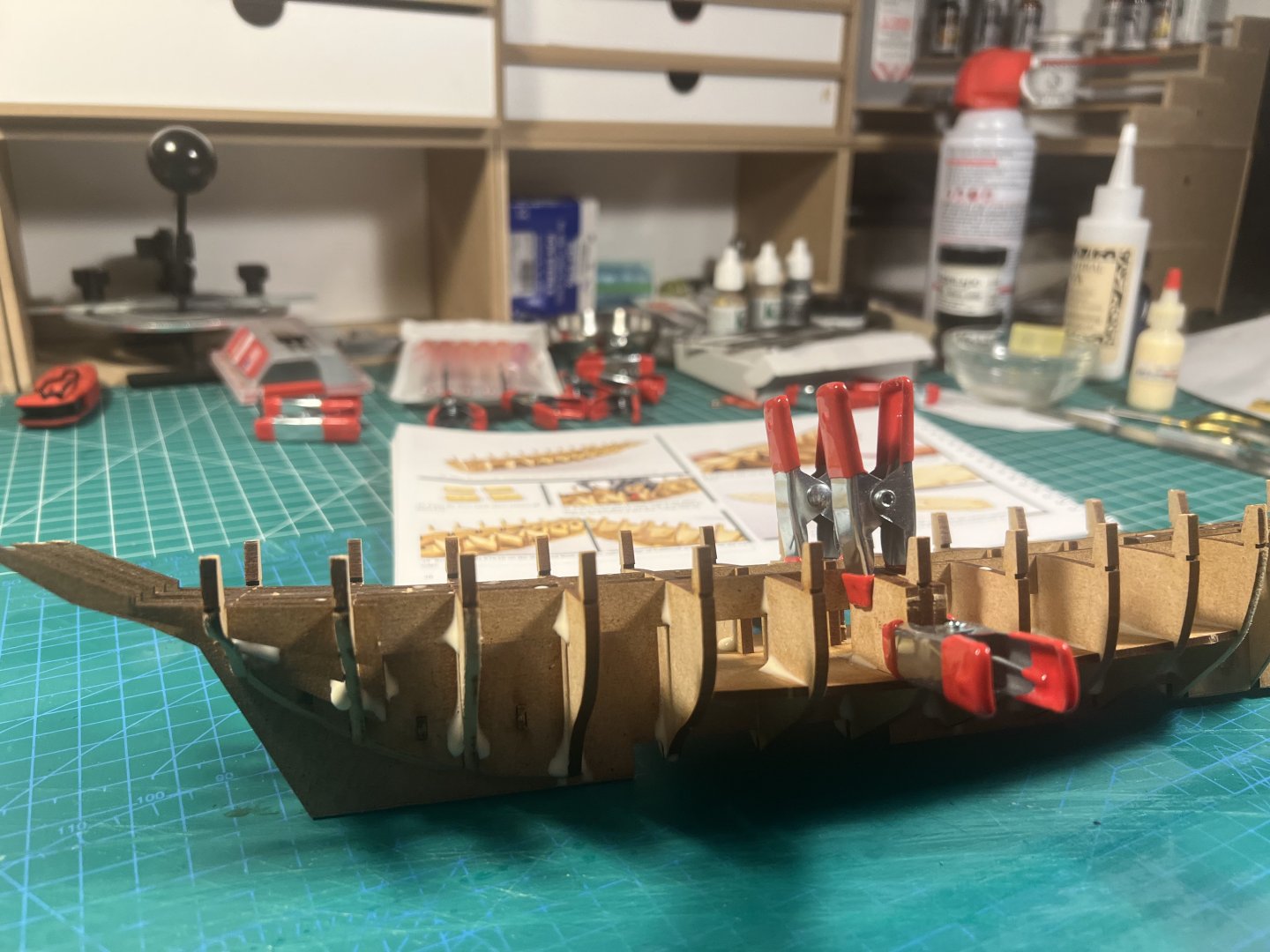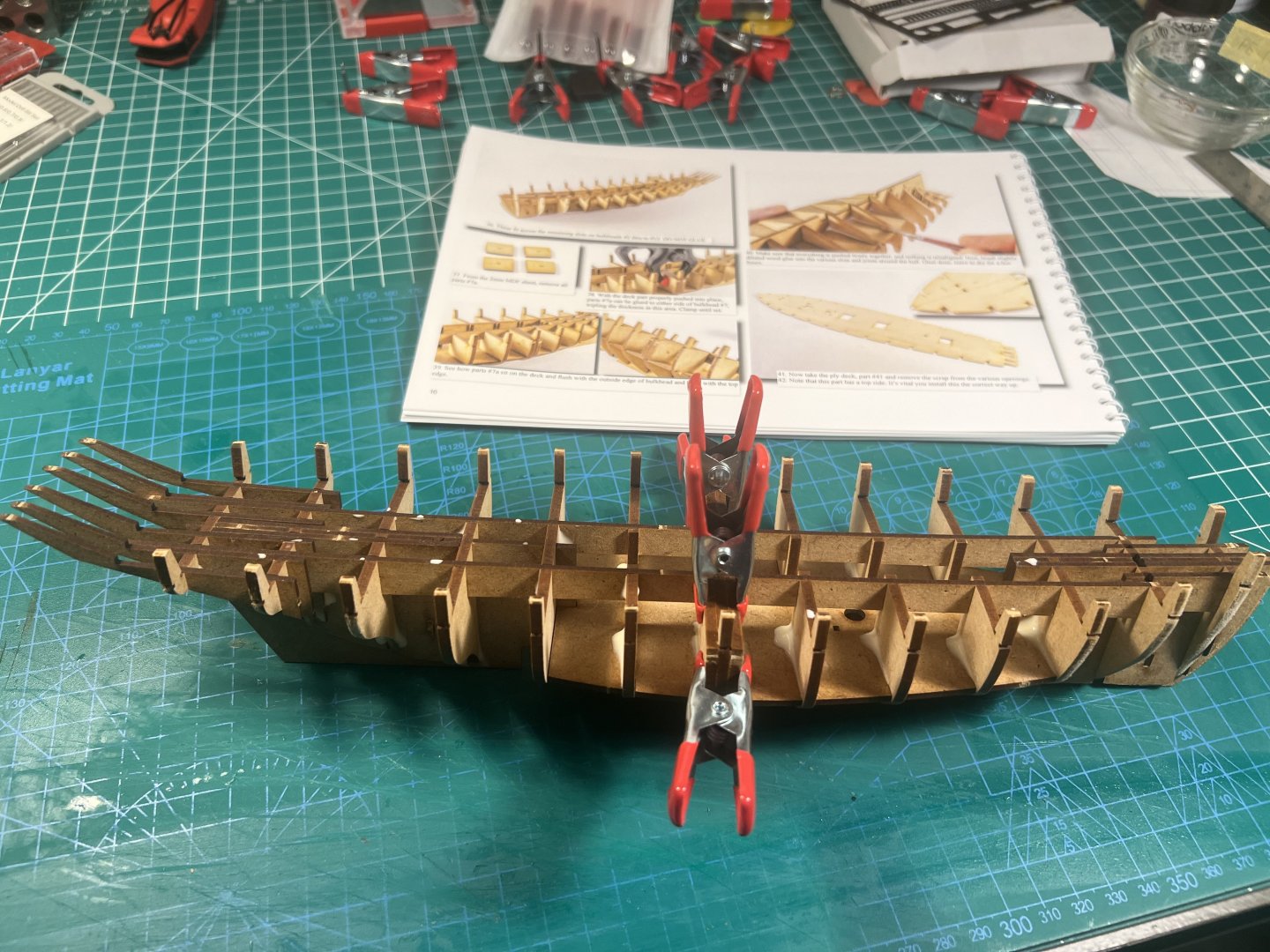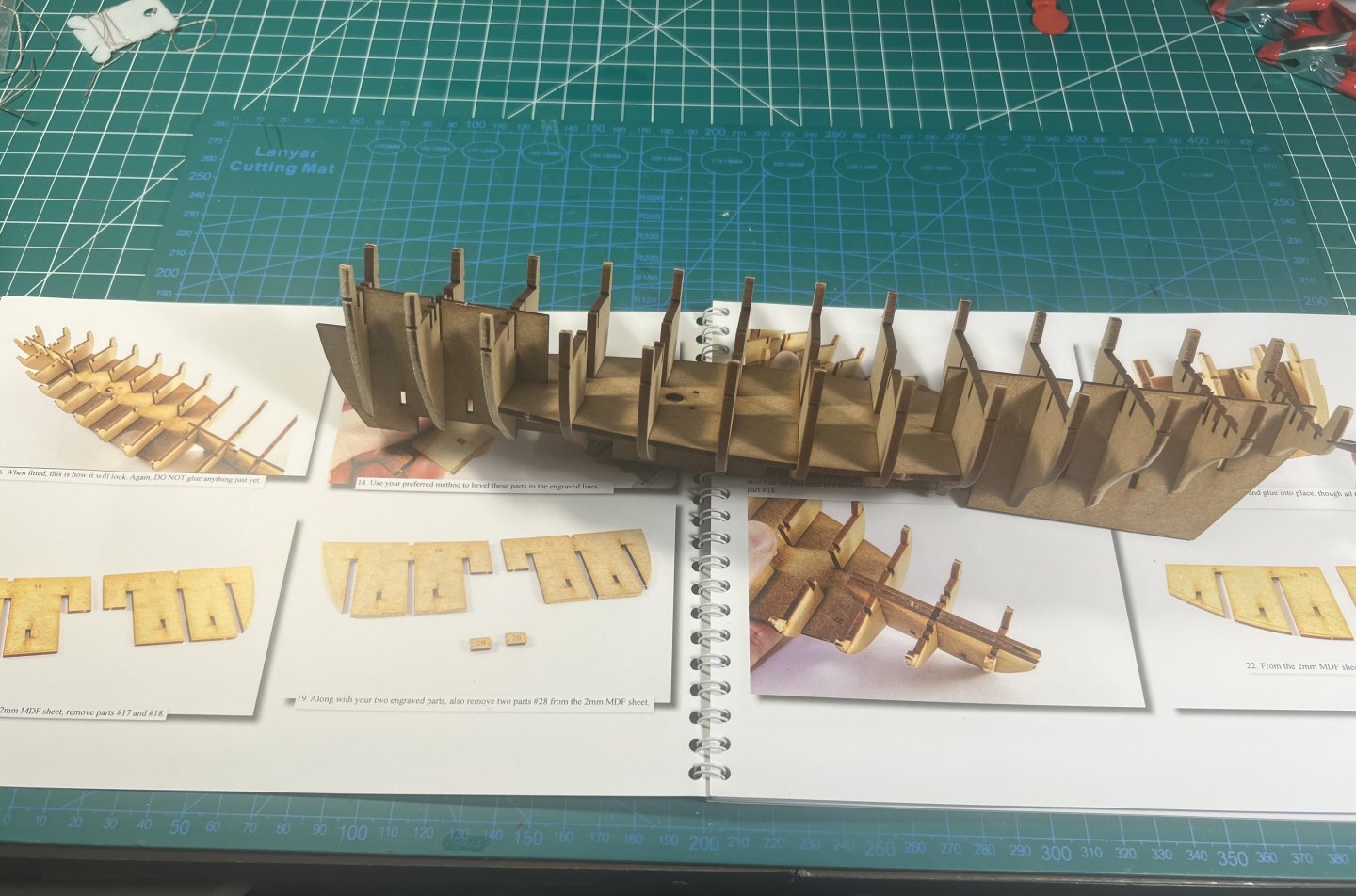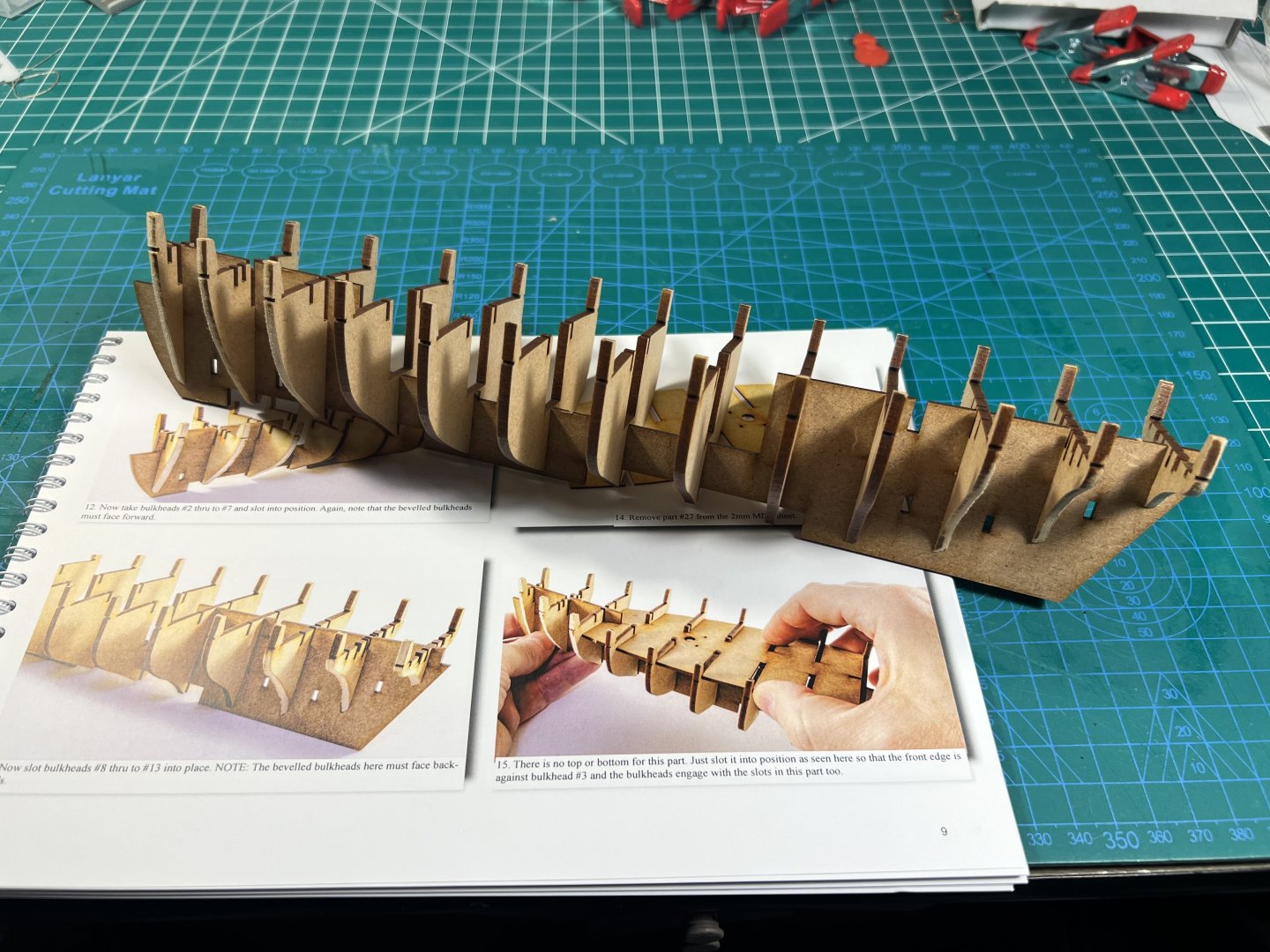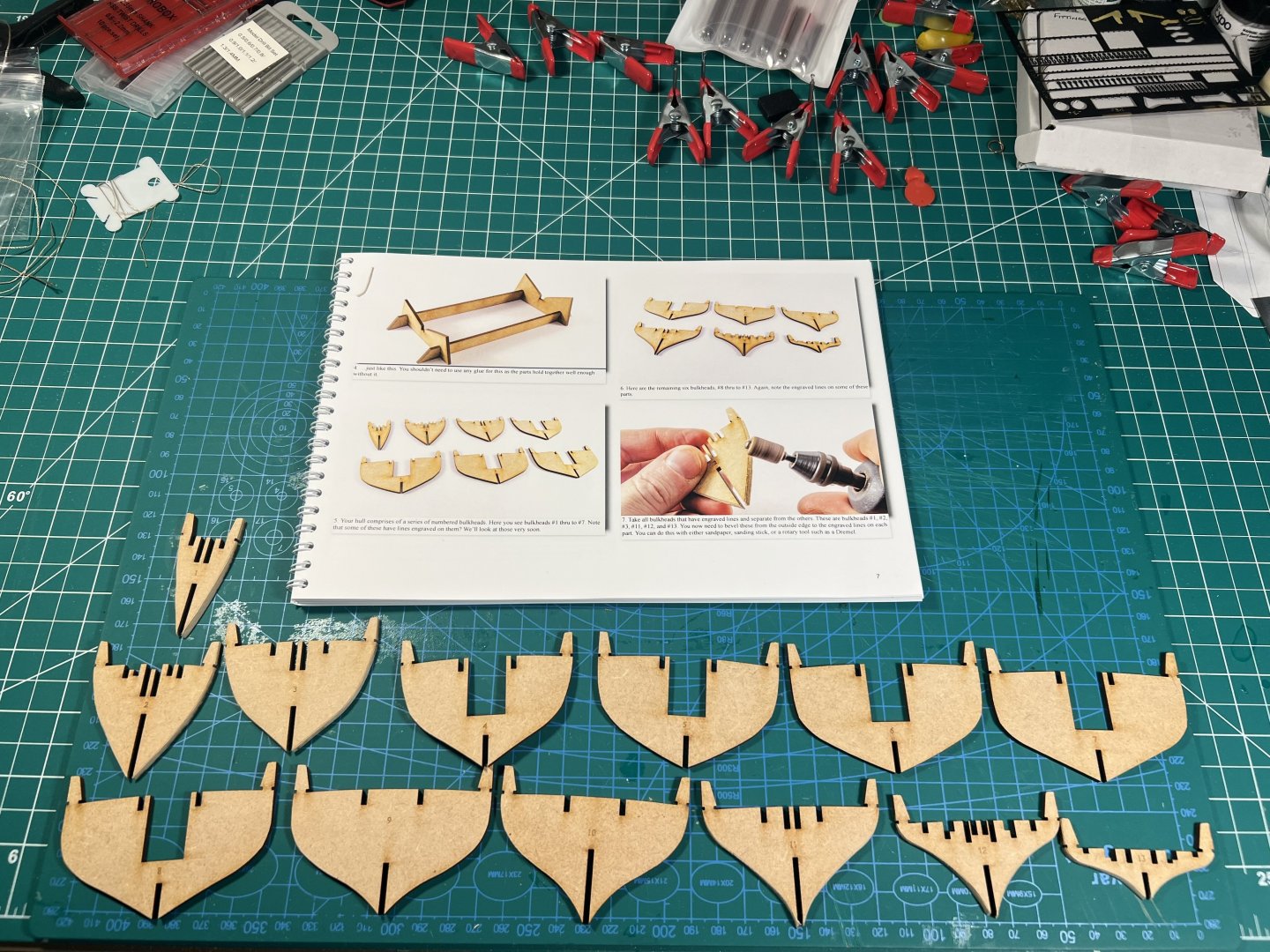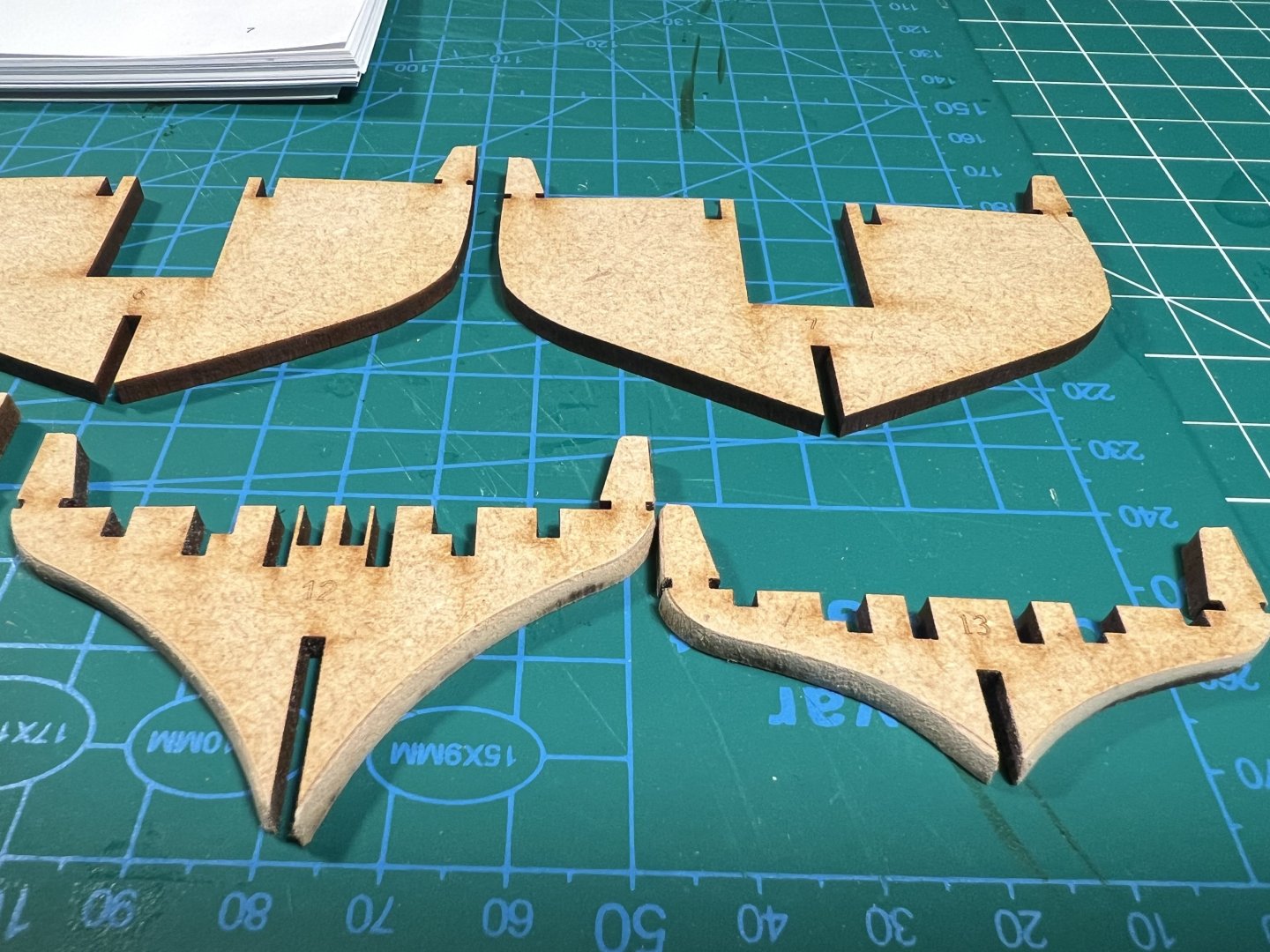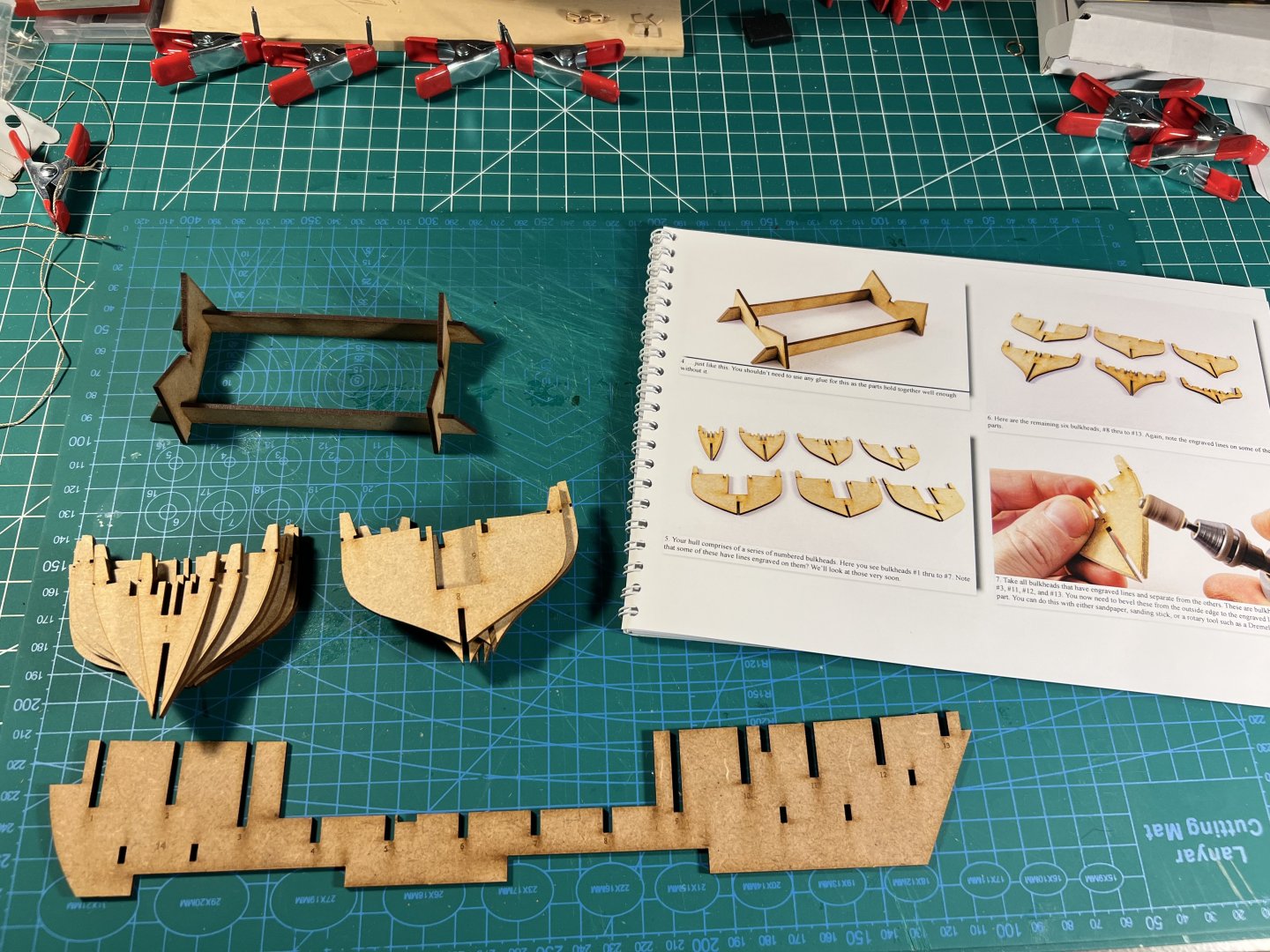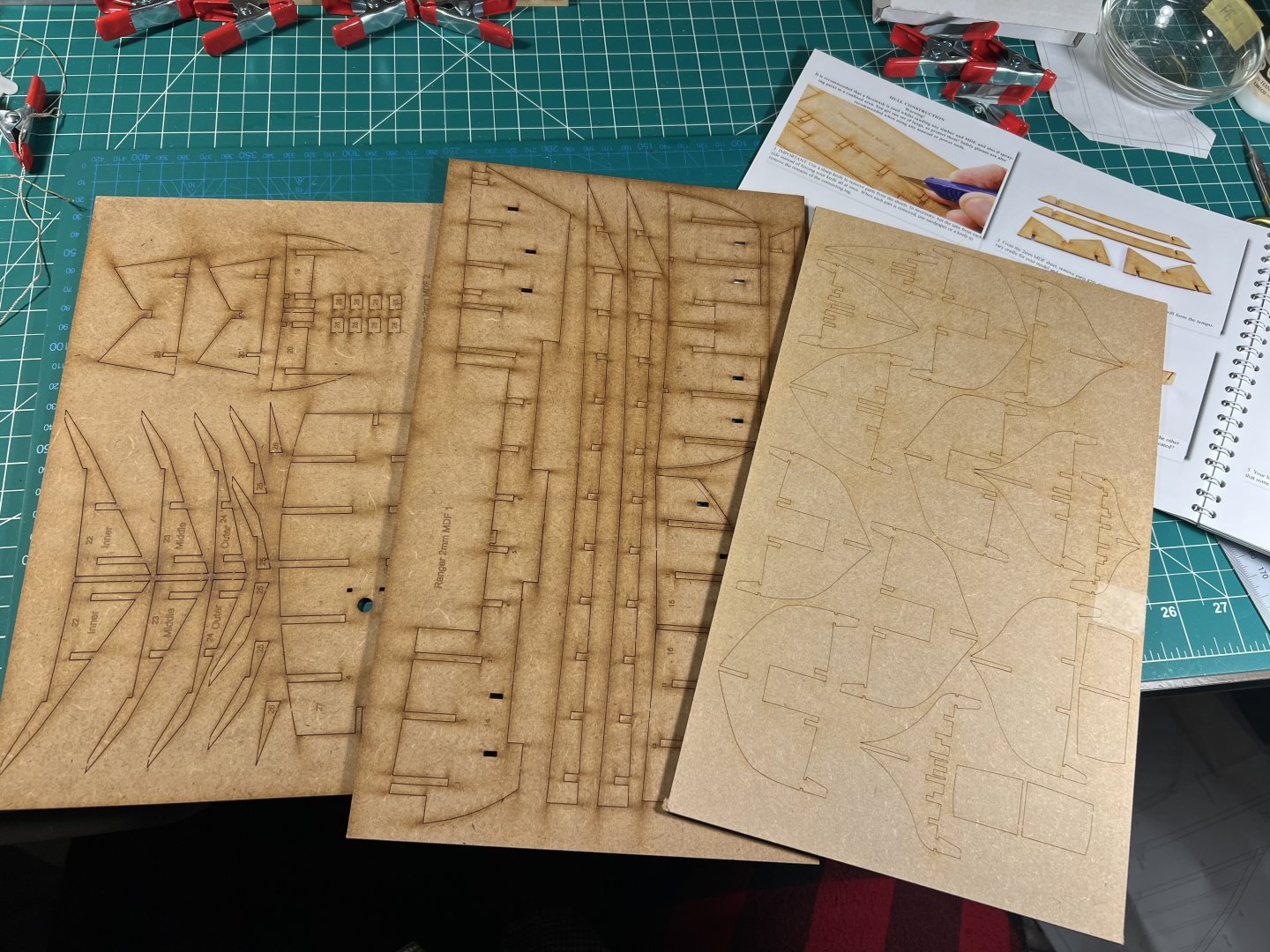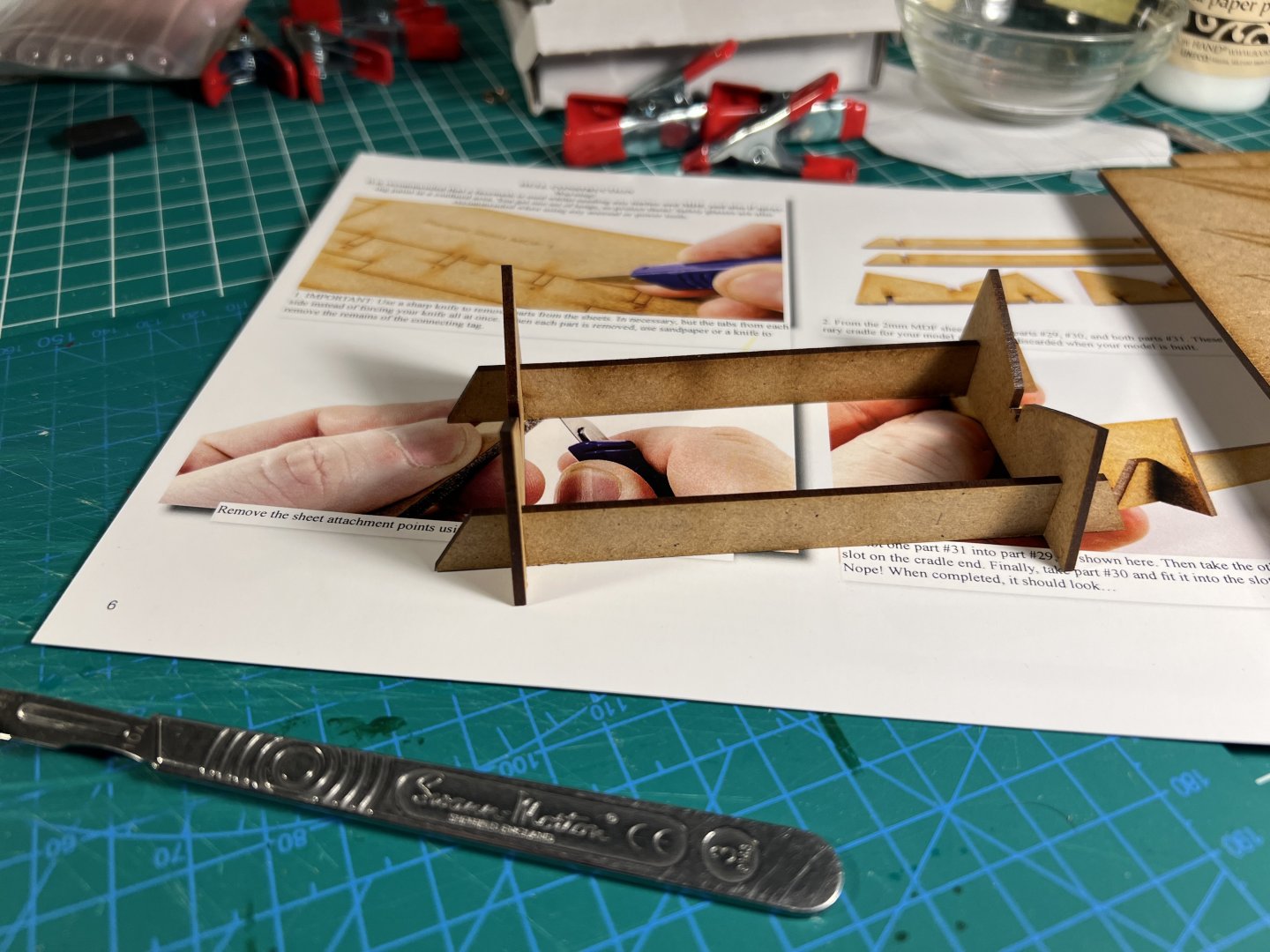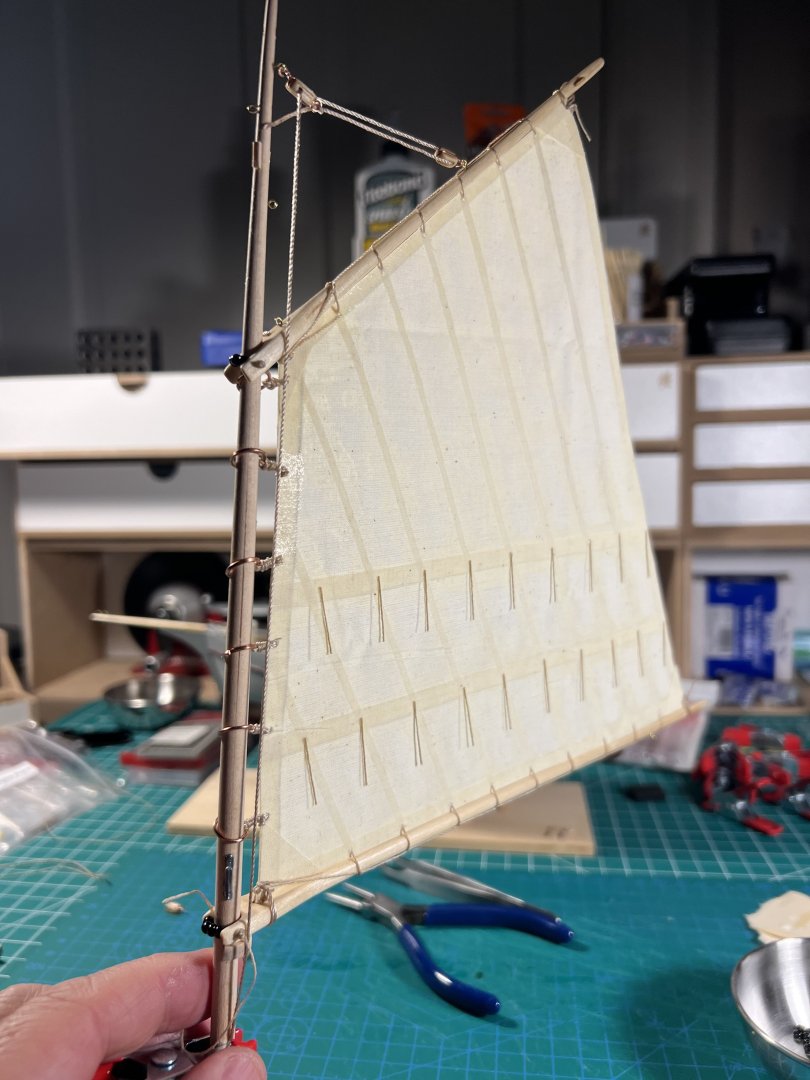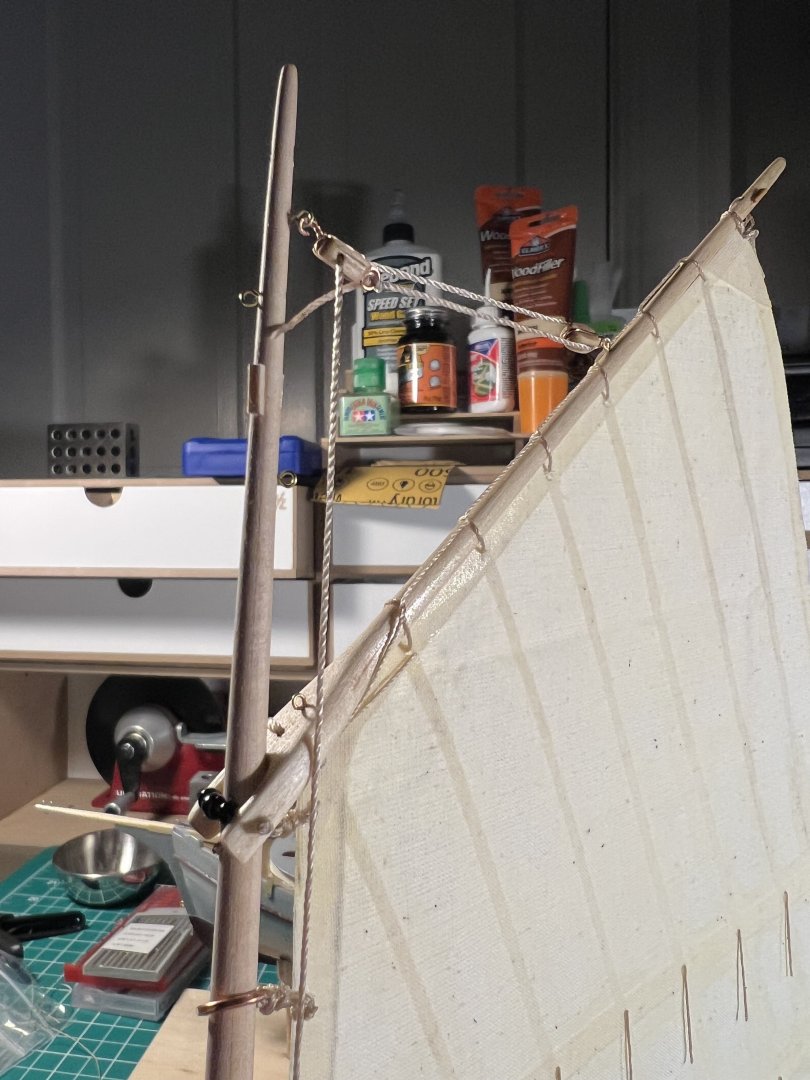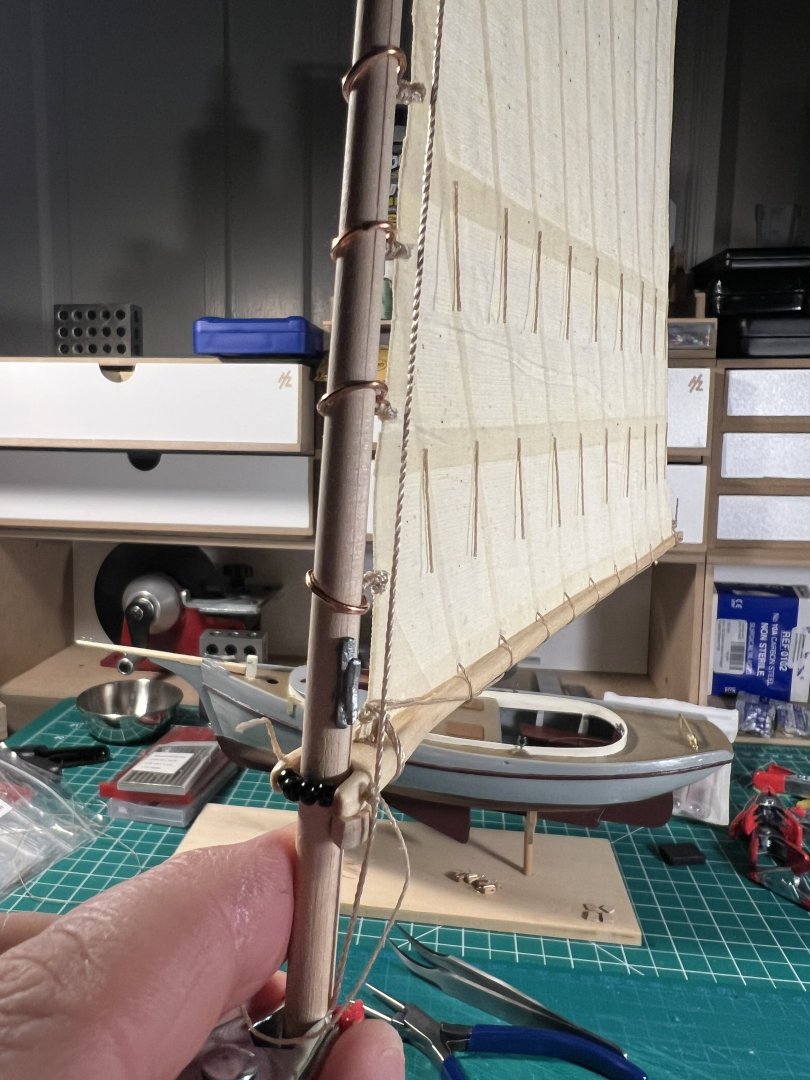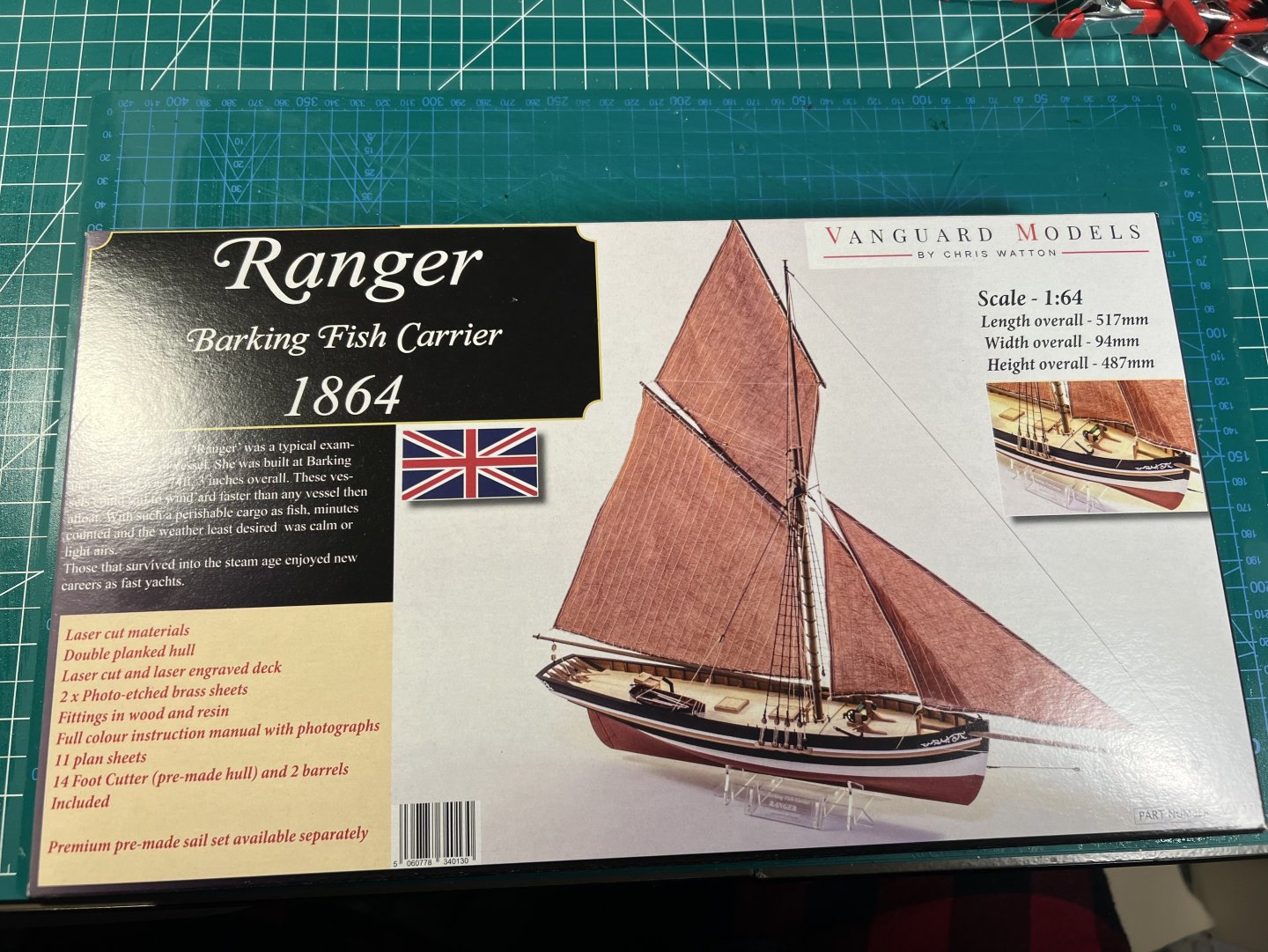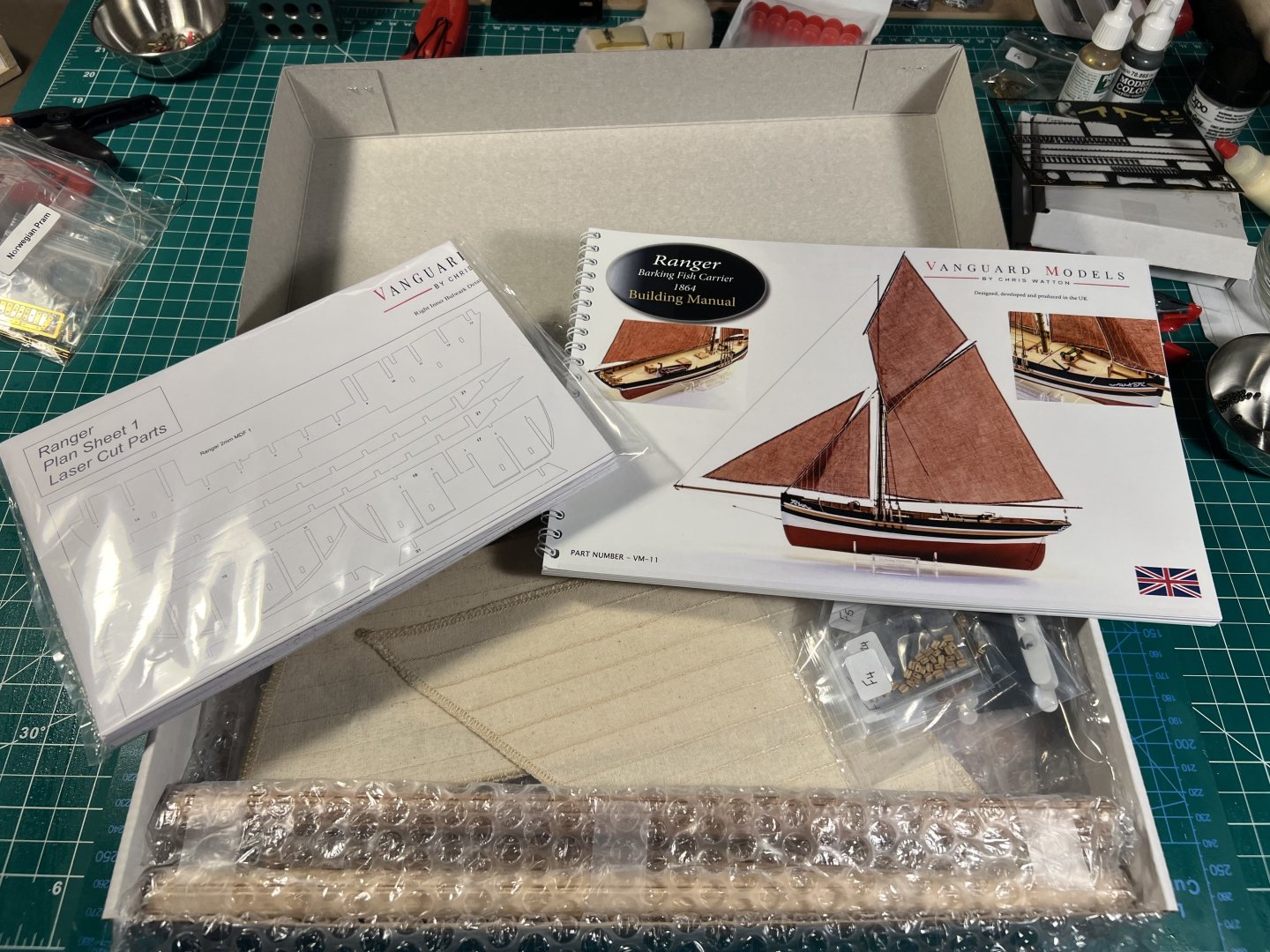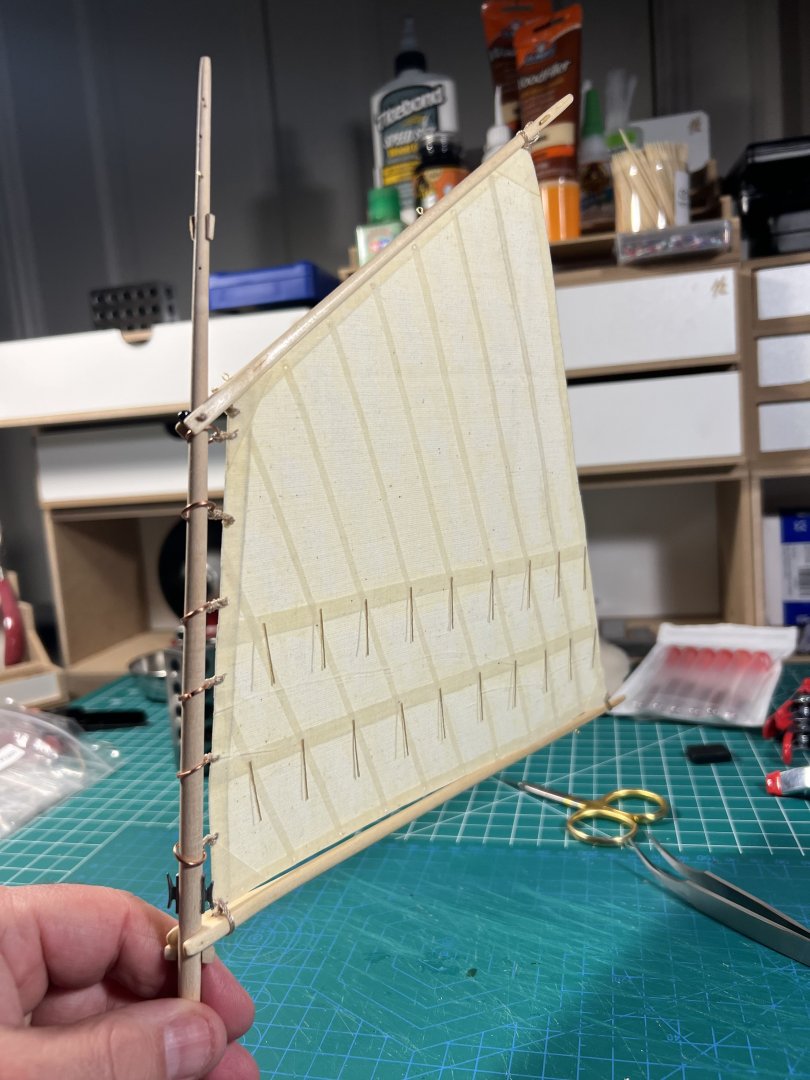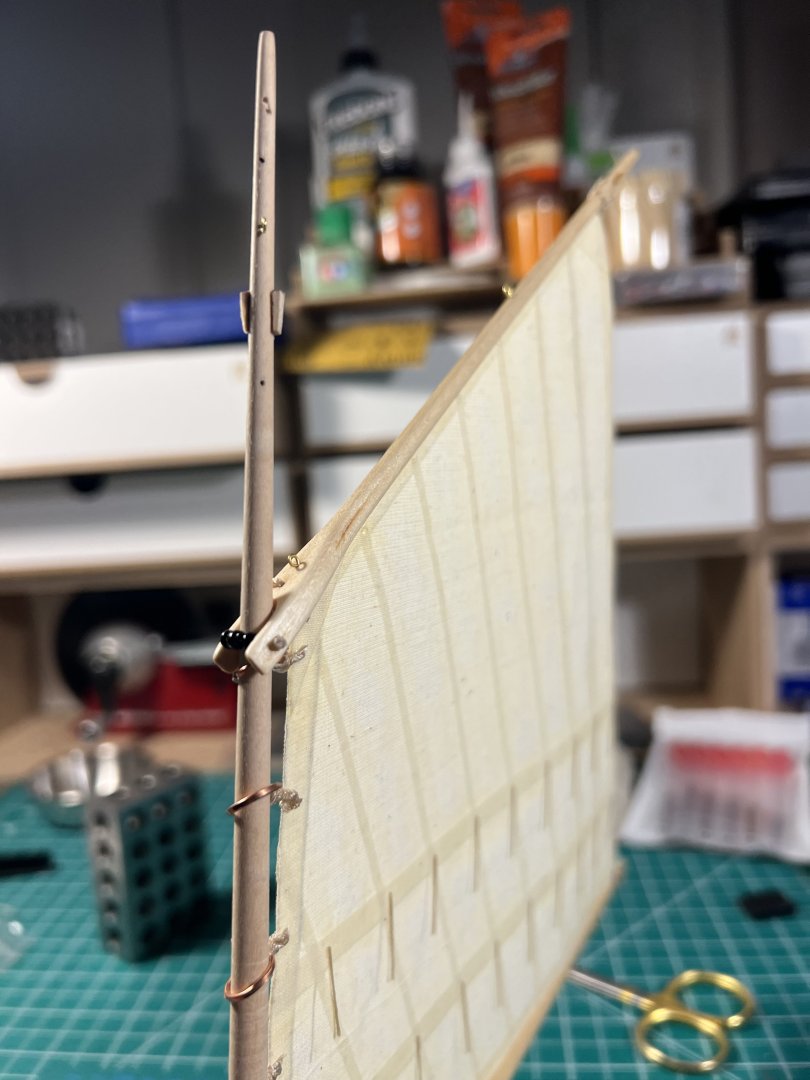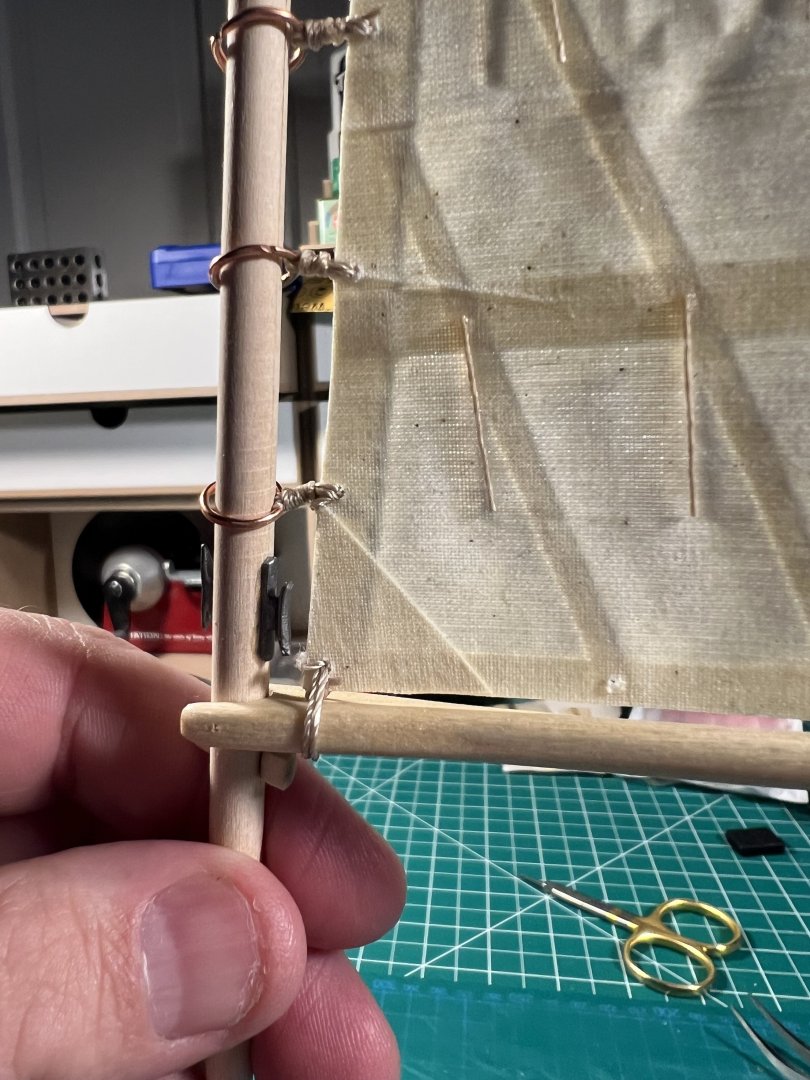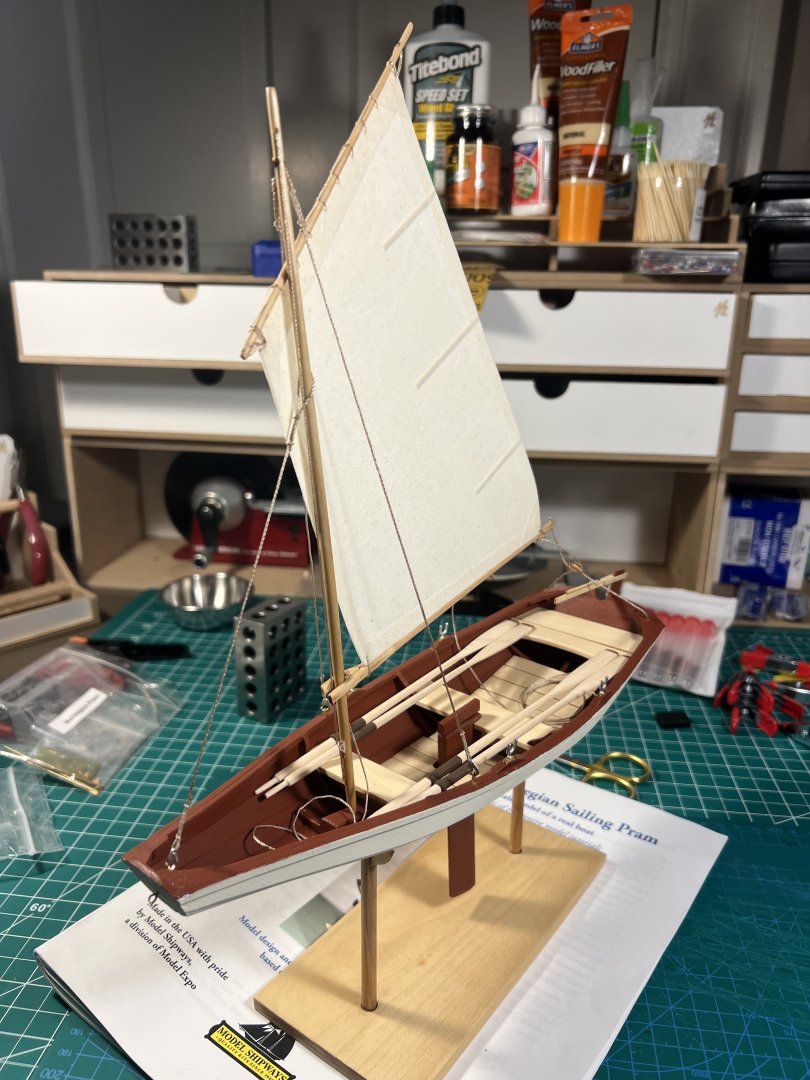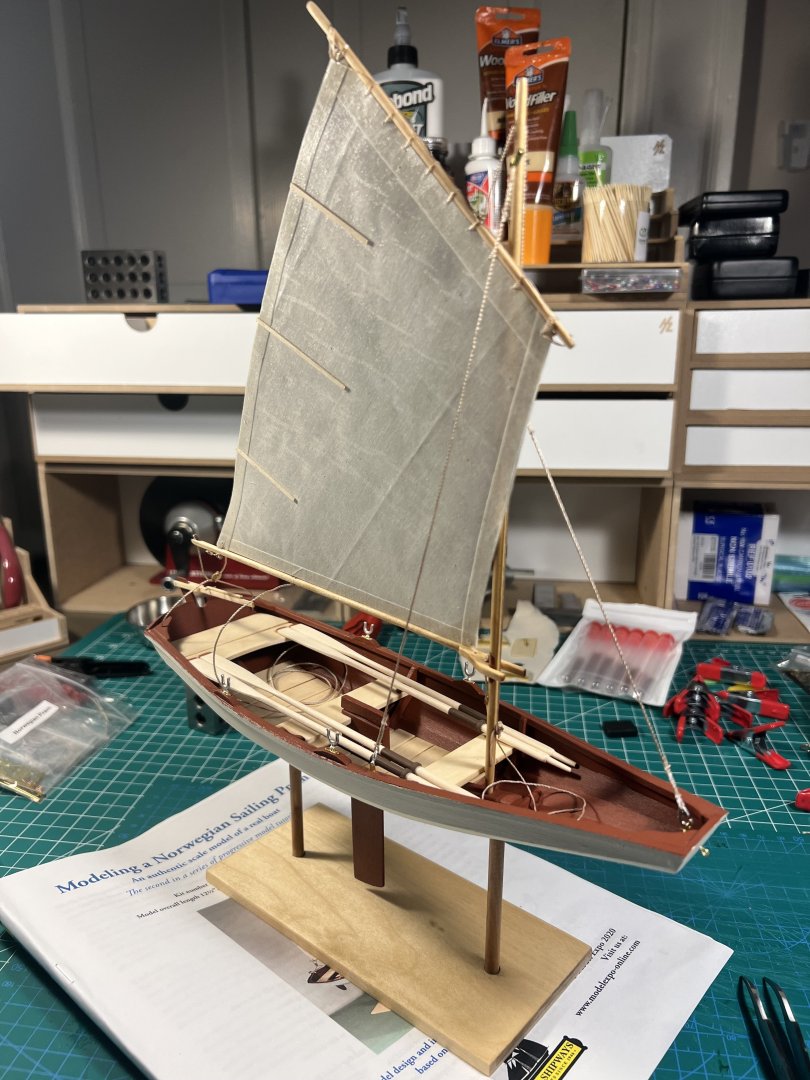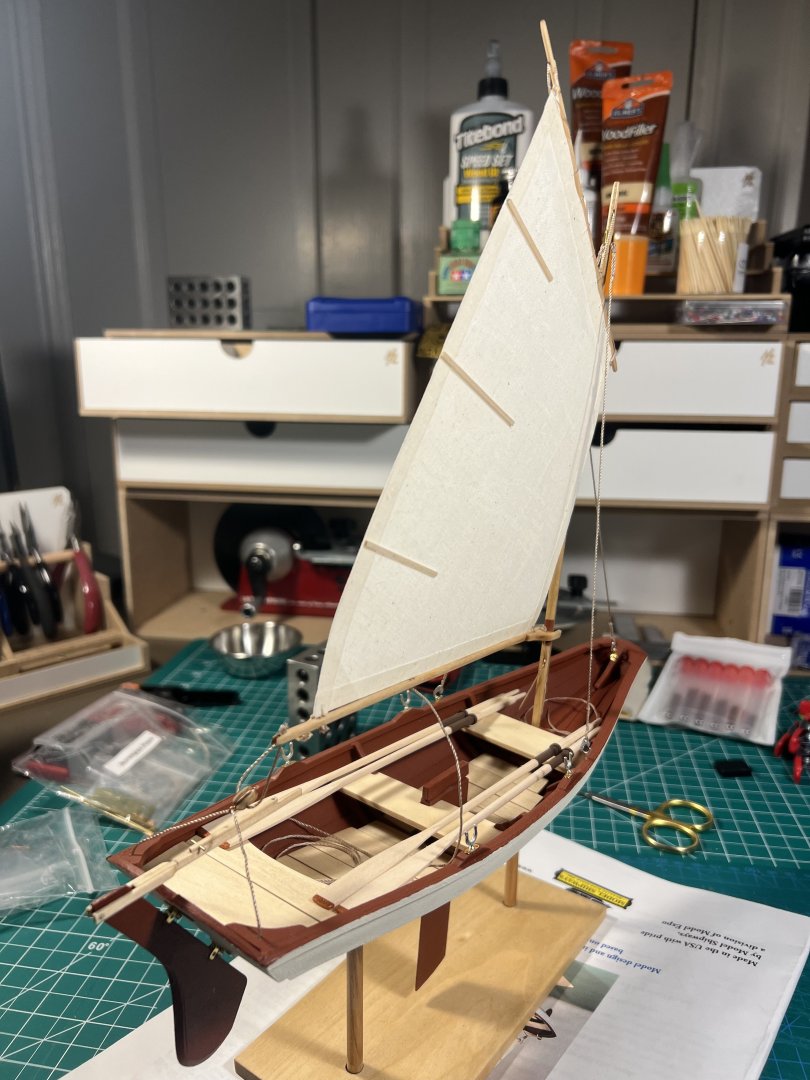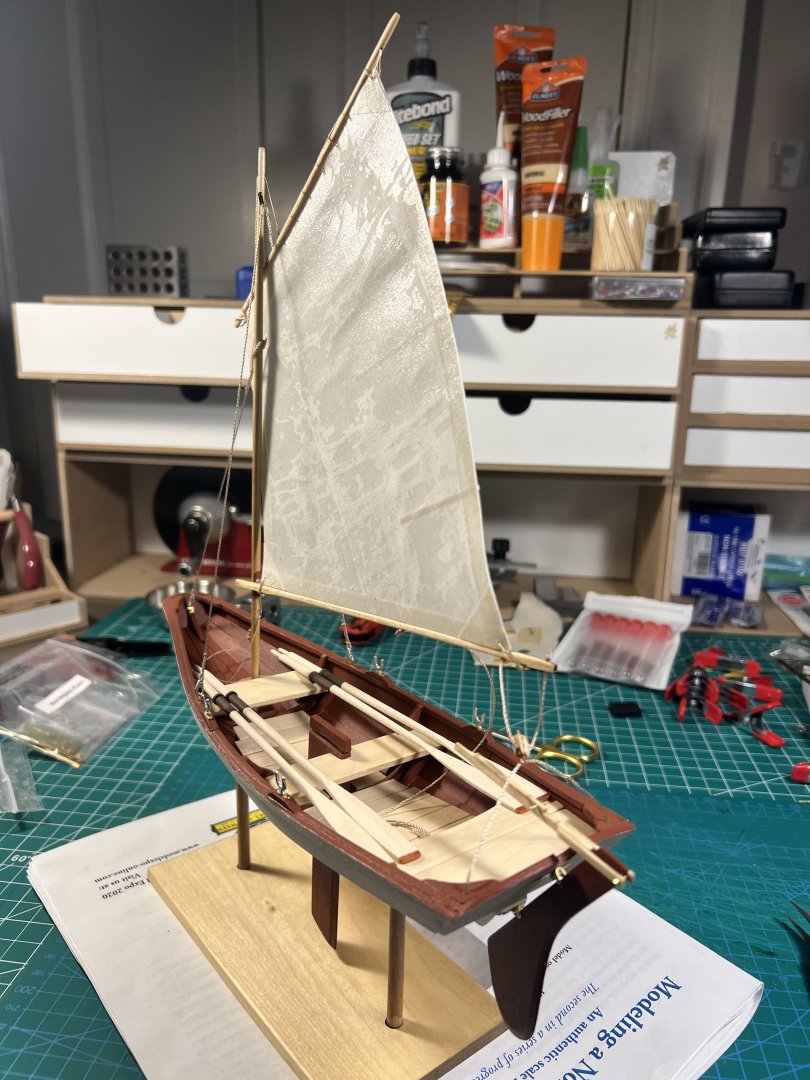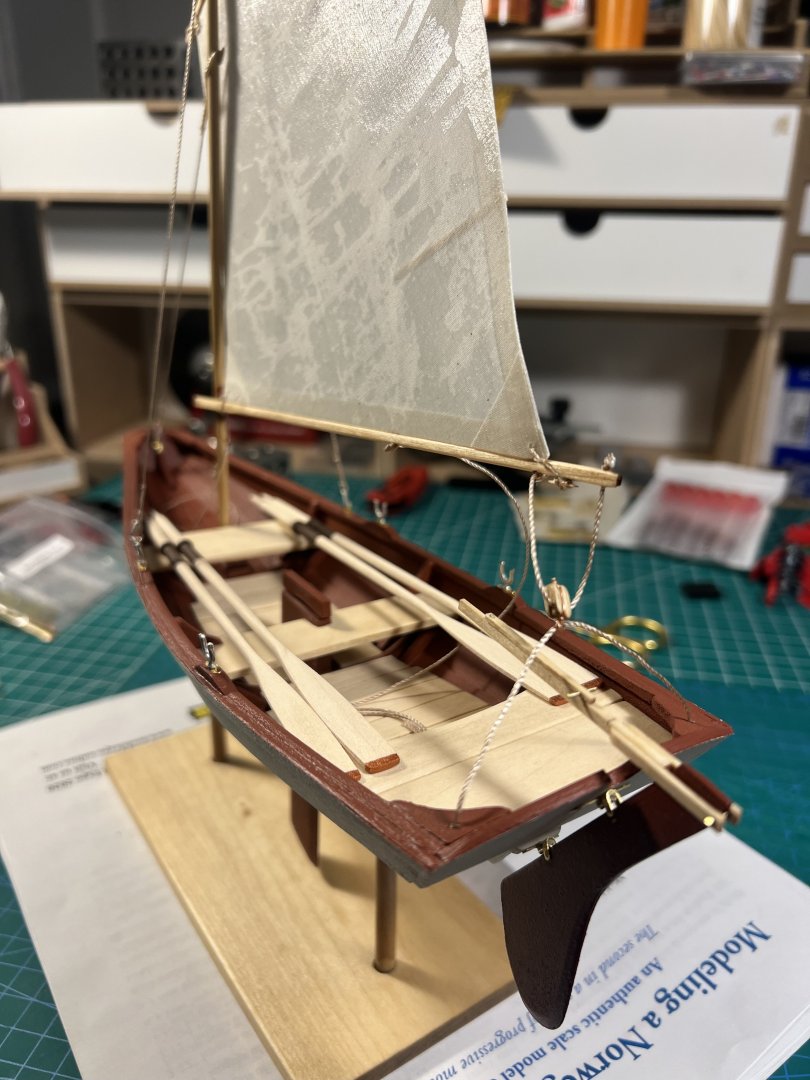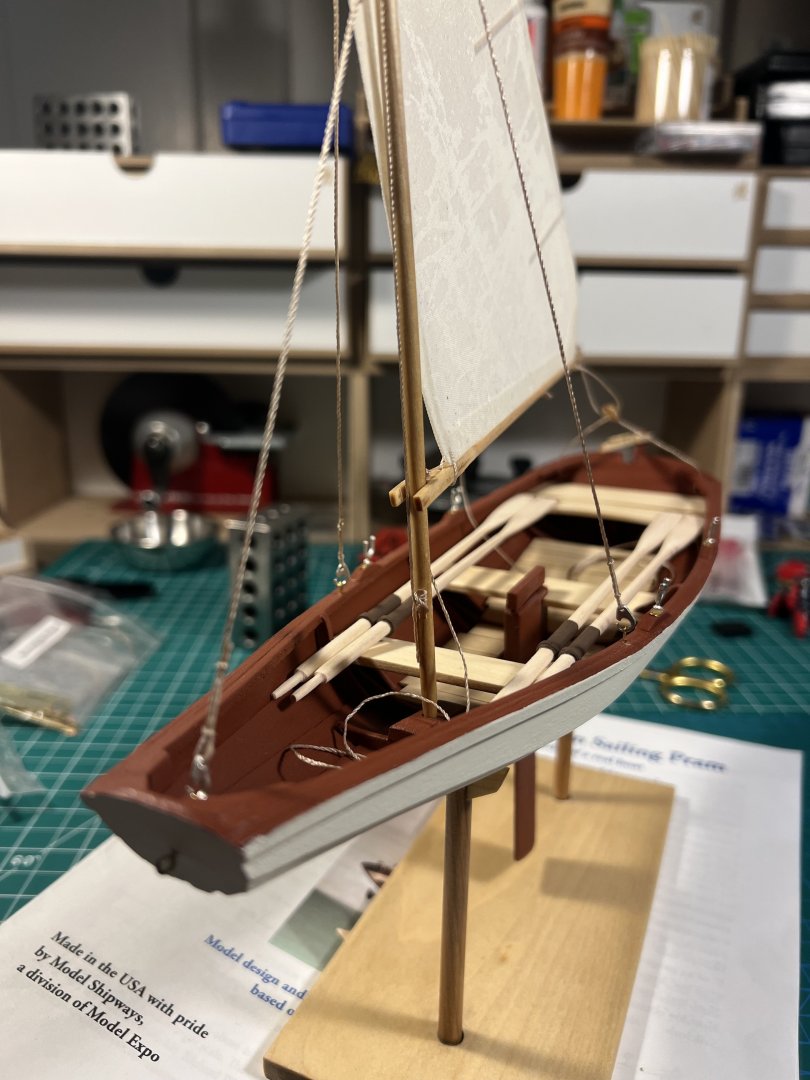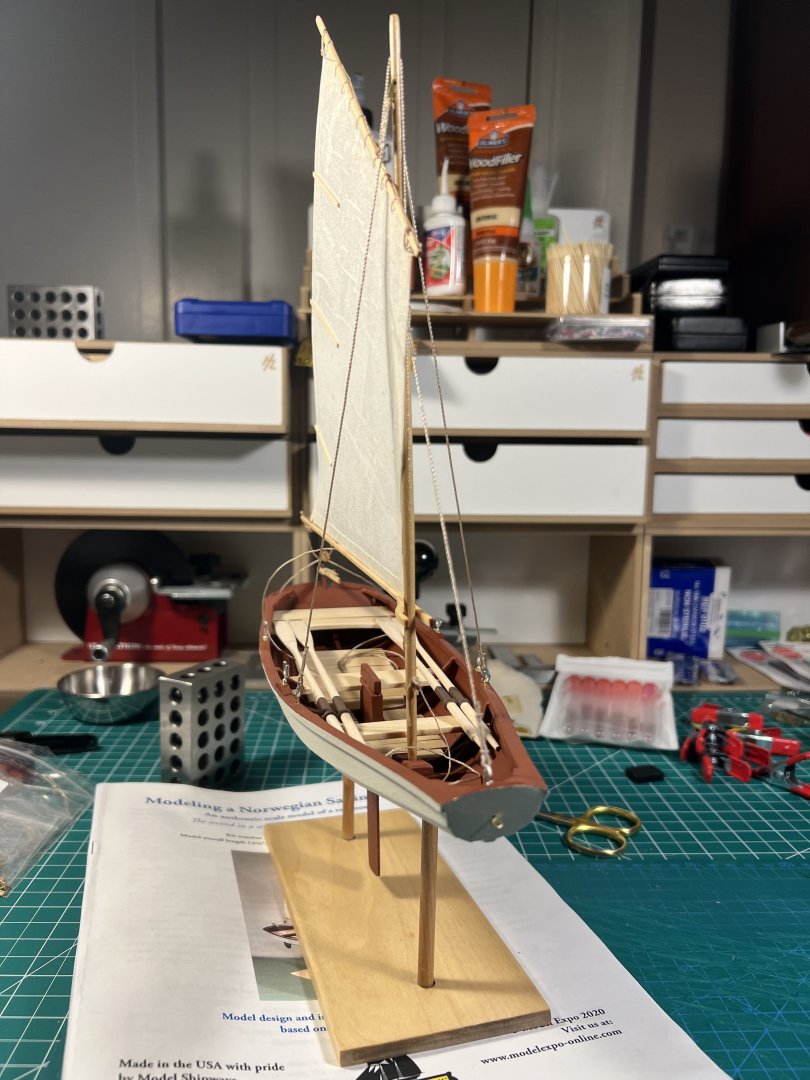
palmerit
NRG Member-
Posts
999 -
Joined
-
Last visited
Content Type
Profiles
Forums
Gallery
Events
Everything posted by palmerit
-
Two baby steps. Added the front part of the keel - this just slid in without any filing. And glued just the narrow edge of the thin maple veneer at the stern, as recommended, to glue the rest into shape after it sets. Since the veneer is so thin, I used clothes pins to hold in place rather than the stiffer clamps. (I bought the clothes pins originally because it’s easy to turn them into customized clamps by drilling and gluing other wood to them.)
- 133 replies
-
- Ranger
- vanguard models
-
(and 1 more)
Tagged with:
-
Sorry. They were the ones included in the Ranger kit. I didn't order them separately. Thanks.
- 133 replies
-
- Ranger
- vanguard models
-
(and 1 more)
Tagged with:
-
Did you experiment with mixing the dyes together vs. doing a dip in one dye and doing a dip in another dye. I'm sure I can read a bunch on how to dye things. Just wondering if you had experimented or had seen videos or posts recommending dye mixing vs. sequential dyeing.
- 133 replies
-
- Ranger
- vanguard models
-
(and 1 more)
Tagged with:
-
Thanks so much for all the pointers and suggestions. @chris watton@James H - what are the sails made from? I might like to buy a little fabric to experiment before trying on the actual sails that came with the kit.
- 133 replies
-
- Ranger
- vanguard models
-
(and 1 more)
Tagged with:
-
Clamping the keel to the underside. Lots of clamps. I had to do a fair amount of filing of the notches to get the piece to fit.
- 133 replies
-
- Ranger
- vanguard models
-
(and 1 more)
Tagged with:
-
I think I did an ok job of faring the hull. @James H said it took him only 20-30min. I probably spent an hour on it. A good bit less time than my Sherbourne, but that was my first. Way less time than my NRG Half Hull, but that hull was way more complicated. I used finger, eye, and a spare strip of thin planking to check. Seems like a pretty easy hull, confirming what I read. We’ll see if the planking goes as easy. (Good to look at the faring the next day with a fresh eye. I saw that I needed to do some more at front and back near the keel. And I saw a few places where some of the frame was bulging a bit from the deck in the place where the additional supports are glued in place in the middle of the ship. I might need to fare a bit more where the counter goes in the stern but I'm waiting a bit since I need to install some of that in a step coming up soon.)
- 133 replies
-
- Ranger
- vanguard models
-
(and 1 more)
Tagged with:
-
Added the ply deck. Had a bit of a better time than I had with my Sherbourne in that none of the tabs snapped off. But the ply did pull up in a few places. I think I need to flex it a bit more. I’m just afraid of snapping it. Once the ply deck is in the whole structure is even stronger. Per the instruction, I glued underneath (with a diluted glue-water mixture) with a brush. I’ll leave it to dry overnight.
- 133 replies
-
- Ranger
- vanguard models
-
(and 1 more)
Tagged with:
-
One thing I was kind of unhappy about - especially in the posted photos - is that shine on the sails. The instructions called for painting the sails with a cream-consistency slurry of water and PVA (I used white bookbinders glue) to stiffen the sail. I don't know if there were other options, the glue slurry needed more water, or if I could have just left the sail unstiffened. The stiffened sail did make mounting it to the mast easier since it was a stiff piece. I didn't see the Vanguard Ranger, which comes with sails, having this step.
- 63 replies
-
- Norwegian Sailing Pram
- Model Shipways
-
(and 2 more)
Tagged with:
-
Finished the main support structures of the hull. Vanguards models are really engineered well. There’s really little concern about not having the hull support pieces at 90 degree angles because there’s so much redundancy in the way the pieces go together.
- 133 replies
-
- Ranger
- vanguard models
-
(and 1 more)
Tagged with:
-
- 133 replies
-
- Ranger
- vanguard models
-
(and 1 more)
Tagged with:
-
Fitted the bulkheads into the keel. There’s no gluing (yet). I had to file the notches on all of the bulkheads because they were quite tight. Pushing them all the way down without filing could have meant snapping a bulkhead or the keel.
- 133 replies
-
- Ranger
- vanguard models
-
(and 1 more)
Tagged with:
-
Next step was beveling the edges on some of the bulkheads (only a few). The beveling was pretty mirror and it maybe took 20 min to do them all.
- 133 replies
-
- Ranger
- vanguard models
-
(and 1 more)
Tagged with:
-
Speaking of parral beads. This model recommends them but does not supply them. I ended up ordering ordering a multipack for around $15 from amazon: https://www.amazon.com/dp/B0CD19WZZC?ref=ppx_yo2ov_dt_b_fed_asin_title It came with small containers with several sizes (from 6/0 to 15/0). I probably have enough "seed beads" to last me multiple lifetimes. I'm sure I could have found a bead store someplace in town. But it was just easier to buy a small pack and now I have them.
- 59 replies
-
- muscongus bay lobster smack
- Model Shipways
- (and 2 more)
-
For my next model with rigging, I'm going to do some more research on knots. This kit suggested double half-hitches everywhere. I don't know if I'm doing something wrong, if the line is just too thick, but the knots seemed large. And my understanding is that you'd really never even have knots on a ship. The knots serve their purpose on the model, but a bunch of huge knots just seems wrong. I also need to research - if I'm using knots - how to get them to be snug when I'm try to get them up against a whole (e.g., for the parral beads along the boom).
- 59 replies
-
- muscongus bay lobster smack
- Model Shipways
- (and 2 more)
-
@DB789 had said in your build log "Decided on a colour for the sails, RIT dye tan (mixed quite strong) and after that the sails dipped for a minute or two in weak RIT dye scarlet mixture, the latter to give the sails a less bland brown colour." Can you unpack that a bit? How strong is strong (for the tan) and how weak is weak (for the scarlet)? I maybe dyed something 40 years ago. How long did you keep the sails in the tan (you specified of the scarlet a minute or two)? Did you use the Rit powder or liquid? Maybe I can start by dying an old t-shirt or something. Any idea what material the sails are made from? The part list in the instructions just say "Cloth". Cotton? Linen? If I'm going to experiment I'd like to find the same material.
- 133 replies
-
- Ranger
- vanguard models
-
(and 1 more)
Tagged with:
-
I cut out the 13 bulkheads and the keel. Next time I’ll need to bevel the bulkheads to the marked lines with my Dremel with a sanding wheel. Then it’ll be dry fitting the bulkheads to the keel.
- 133 replies
-
- Ranger
- vanguard models
-
(and 1 more)
Tagged with:
-
- 133 replies
-
- Ranger
- vanguard models
-
(and 1 more)
Tagged with:
-
- 59 replies
-
- muscongus bay lobster smack
- Model Shipways
- (and 2 more)
-
One thing I'm trying to do before starting this is ordering paint for the model and dye for the sails. I won't be getting to the sails any time soon, but painting the hull will be potentially weeks away and sometimes it takes a bit for the paint to arrive. I've found scalehobbyist.com has good prices and a good selection of Vallejo paints. I really like Vallejo Air paints. They work well with my Iwata Airbrush - or at least I've figured out how to use them. The Ranger instructions recommend spray cans, I think of enamel-based paints. I have an airbrush booth in my house, but I know from the couple times I used some enamel spray paints (Tamiya primer on PE), even with the spray booth fan running full speed, it still was too strong for inside. I might need to experiment a bit with mixing some Vallejo colors to find something close. For the white, I'll use the Vallejo Air Off White (Creamweise) 71-270, which I used for my Sherbourne - I think Chris Watton recommended that one. Unless someone recommends something else, I'll go with that. For the black, for now I'm planning on the Vallejo Air Black 71-057, which I also used on my Sherbourne. The opening instructions call for a "Black Red-Brown paints (recommend either Humbrol, Vallejo or Tamiya)" but then just refer to "matte black" later on. I have some other black shades I bought for other projects that I can play around with if I want something that has a red/brown shade to the black. I wasn't sure what "Black Red-Brown" might be. The opening of the instructions does not note that a flat green is also used later on for the windlass and what looks to be an exhaust port of some kind (I'm sure that part has a real name) - I noticed it when skimming the instructions. I think I'm going to order a Vallejo Air Pale Green 71-095 and a Vallejo Model Game Air Angel Green 76-123 and see if some mixture works ok. There wasn't really a good match with in the Vallejo Air paints (https://acrylicosvallejo.com/en/). I was going to maybe try the regular Vallejo (which would need to be thinned quite a bit) Splinter Green 70-756 but scalehobbyist.com does not seem to carry it. The toughest is finding a replacement for the "Red Oxide (Hull below waterline) (Recommend Plastikote Red Oxide Primer)" in the Vallejo line. I've found a few options that hover around that color, but it's probably going to take some experimenting in mixing to get a shade I like since nothing really seems to match. Vallejo Air Red 71-102 (which I have already, and would need to be mixed with something browner) Vallejo Air Red (Rot) 71-269, which oddly seems to have the same name, different number, and a somewhat different shade (a bit more "red oxide" than the other red) Vallejo Game Air Scarlet Red 76-012, which definitely would need to be mixed with other reds Vallejo Game Air Nocturnal Red 76-111, which also would need to be mixed Vallejo Air German Red Brown (Rotbraun) 71-271, a browner, more oxide-like, but not red enough I also have some regular Vallejo colors that I could use as mixers (like Vallejo Red Leather 70-818, also not red enough). There was also a blue used as trim around the small deck boat (which is 3D printed). I had bought Vallejo Air French Blue 71-088 and Vallejo Air Magic Blue 76-021 when I thought the Duchess would be my next model. I think one of them would work well. No idea what shade to use to dye the sails - not that that step is coming any time soon. The instructions don't say. I saw in the instructions for another Vanguard fishing boat, the Lady Eleanor, that it said "You can use any dye of your choice, but for prototype, this is the product we used" and it shows a Rit dye in Wine (Bordó). The only other Ranger build (aside from James's prototype) was one by @DB789 who said "Decided on a colour for the sails, RIT dye tan (mixed quite strong) and after that the sails dipped for a minute or two in weak RIT dye scarlet mixture, the latter to give the sails a less bland brown colour."
- 133 replies
-
- Ranger
- vanguard models
-
(and 1 more)
Tagged with:
-
Well, about 30min after finishing my Pram, I've decided my next build: The Vanguard Models Ranger - Barking Fish Carrier - one of several fishing boats Vanguard offers. Months back, I thought my next model would be the Vanguard Duchess of Kingston that I bought, which I originally intended to be my second model after the Sherbourne. But then I realized that I wanted to get more experience with some smaller boats before tackling a larger and more expensive model ship like the Duchess. My first step was getting the Model Shipways Shipwright Series, having completed the Dory and Pram, with the Smack nearly complete. I also snuck in the NRG Half Hull after realizing I also needed some more planking practice. Then I discovered some builds of the Vanguard fishing boats. Seeing a nice Black Friday sale at agesofsail.com back in November I decided to buy the Ranger, Zulu, and Erycina. The Ranger and Zulu are Level I Novice builds, the Erycina is a Level II Amateur build. Someone who built all six models noted that the Ranger, Zulu, and Erycina are larger models, with the Saucy Jack, Nisha, and Fifie their somewhat smaller cousins. There are only a handful of build logs for the Ranger.
- 133 replies
-
- Ranger
- vanguard models
-
(and 1 more)
Tagged with:
-
- 59 replies
-
- muscongus bay lobster smack
- Model Shipways
- (and 2 more)
-
I gotta finish my Smack (almost done) and my Sherbourne (was waiting to do the rigging on the Pram and Smack before getting to that). I have more models in the cellar on a shelf than I can count. I was probably going to go peruse them in a bit and pick the next one. I decided I'm going to wait to begin the Duchess, which I had said would be my second model. Then I decided to do the Dory, Pram, and Smack, and the NRG half hull. Then I got caught up in Black Friday sales and decided to buy some of the Vanguard fishing boats since they were easy models. And I somehow late at night pulled the trigger on some other models. Oh, and I inexplicably ordered the Pavel Nikitin Oseberg v3 last week. What was I thinking? I literally have about 10 years of models. I need to stop. Or take a pill.
- 63 replies
-
- Norwegian Sailing Pram
- Model Shipways
-
(and 2 more)
Tagged with:
-
- 63 replies
-
- Norwegian Sailing Pram
- Model Shipways
-
(and 2 more)
Tagged with:
-
Yeah, this model really needs to be fared pretty aggressively at the bow and stern (at least compared to what I had to do on the Sherbourne). Even after an aggressive faring, I realized later that I probably could have (should have) done a bit more, especially near the counter at the stern. Having the thin basswood for the planking has the advantage that they're easy to bend and shape. But it also has the disadvantage that, because they're thin, they cannot take much sanding. If the faring is not done right and there are bulges or pockets you cannot fix that by sanding the planks - as I learned when I sanded through and had to replank in places. (I can hold my hull up to the light and see some places where the planking is nearly paper thin.)
About us
Modelshipworld - Advancing Ship Modeling through Research
SSL Secured
Your security is important for us so this Website is SSL-Secured
NRG Mailing Address
Nautical Research Guild
237 South Lincoln Street
Westmont IL, 60559-1917
Model Ship World ® and the MSW logo are Registered Trademarks, and belong to the Nautical Research Guild (United States Patent and Trademark Office: No. 6,929,264 & No. 6,929,274, registered Dec. 20, 2022)
Helpful Links
About the NRG
If you enjoy building ship models that are historically accurate as well as beautiful, then The Nautical Research Guild (NRG) is just right for you.
The Guild is a non-profit educational organization whose mission is to “Advance Ship Modeling Through Research”. We provide support to our members in their efforts to raise the quality of their model ships.
The Nautical Research Guild has published our world-renowned quarterly magazine, The Nautical Research Journal, since 1955. The pages of the Journal are full of articles by accomplished ship modelers who show you how they create those exquisite details on their models, and by maritime historians who show you the correct details to build. The Journal is available in both print and digital editions. Go to the NRG web site (www.thenrg.org) to download a complimentary digital copy of the Journal. The NRG also publishes plan sets, books and compilations of back issues of the Journal and the former Ships in Scale and Model Ship Builder magazines.

